- Our Mission

Teaching Students to Paraphrase
Ideas for scaffolding paraphrasing so that students correctly learn this valuable but difficult-to-master skill.

When discussing text in the classroom, it’s tough for students to shift from utilizing an author’s words (copying) to accepting the challenge to express that author’s idea in their own words (paraphrasing).
But teaching effective paraphrasing is necessary because the use of paraphrasing facilitates important literacy skills : It encourages repeated reading, develops note-taking habits as students track quotes and outline text details, and expands vocabulary as they consider appropriate ways to describe the original text. The skill may seem daunting to students because it takes time to find the appropriate words to reshape a sentence, but that is time well spent.
We also need to teach paraphrasing, of course, so that students develop the skill set required to avoid committing plagiarism unintentionally .
Student Tools
One way to support students is to make them aware of tools that may help when they’re paraphrasing. Think of these as training wheels—students won’t use them forever.
Academic Phrasebank : Ready-made phrases help students organize their sentences when they paraphrase. The site provides sentence starters for defining ideas, comparing and contrasting ideas, describing cause and effect, and explaining evidence to support statements.
For instance, if a student were paraphrasing vocabulary word X, they would be able to find sentence starters such as “The word X encompasses...,” “The word X is challenging to define because...,” and “The word X is intended to....”
Ashford University Writing Center : This website has a five-item quiz to review the paraphrasing process. It allows students to identify examples and non-examples of paraphrasing for a given text.
When examining non-examples, students are shown how replacing or rearranging words is akin to copying and pasting on a computer. Students see examples of effective paraphrasing, including a change of sentence structure or personal elaboration combined with limited quoted information.
Tone Analyzer : This tool allows students to enter a brief sample from a text and receive an analysis of the tone. When using this tool, students can request an assessment of whether the text illustrates anger, joy, sadness, etc. In addition to these emotions, the website includes language descriptors such as confident (used to describe texts that use active voice and/or words such as will , must , etc.) or tentative (texts with words such as seems , appears , might , etc.). This tool is useful in helping students successfully align the tone of their paraphrased material with the tone of the original text.
Student Self-Check Prompts
Students should outgrow the tools above, and teachers can encourage that growth by showing them how to monitor their own progress with paraphrasing. Students can self-check to determine how on track with paraphrasing they are by asking themselves these questions:
- Can I identify elements of the text that are most significant (and thus appropriate to preserve) when I put it in my own words?
- Can I recite elements of the text from memory in order to prepare to put it into my own words?
- How can I adjust the sentence structure to preserve the meaning of the text?
Student Cautions
Because the journey to paraphrasing may involve a few hiccups, it’s a good idea to identify potential student challenges. When paraphrasing, remind students that they should:
- Attempt to describe the text in their own words gradually, one component at a time (thanks to Doug Lemov and Maggie Johnson for this close reading strategy). For instance, they might first use their own words to describe significant phrases in the reading, and then make an effort to explain one or two key sentences, and finally attempt to paraphrase an entire paragraph.
- Monitor the similarities between the text and the paraphrase. For instance, after describing specific sentences or paragraphs, they should note how many words are shared. Instead of using the same words as the author, focus on mirroring the same main idea. The Poorvu Center for Teaching and Learning at Yale offers easy-to-follow models for how to achieve this.
- Ensure that there is a sufficient number of word substitutions in the paraphrased material. (Substituting only a couple of words could constitute plagiarism.) Students should focus on changing the structure of the sentence . This may involve converting a simple sentence to a compound sentence or adding a prepositional phrase.
- Avoid adjusting special language (acronyms, figurative language, jargon, etc.). These kinds of terms are considered common knowledge, so using them in a paraphrase doesn’t constitute plagiarism. Resources such as the Purdue Online Writing Lab can help students figure out whether a particular term is common knowledge.
Teachers can push students to move beyond copying by encouraging them to see paraphrasing as the go-to reading response. When we equip students with needed resources, we make student voice the rule instead of the exception.
I Used My Own Words! Paraphrasing Informational Texts

- Resources & Preparation
- Instructional Plan
- Related Resources
Paraphrasing helps students make connections with prior knowledge, demonstrate comprehension, and remember what they have read. Through careful explanation and thorough modeling by the teacher in this lesson, students learn to use paraphrasing to monitor their comprehension and acquire new information. They also realize that if they cannot paraphrase after reading, they need to go back and reread to clarify information. In pairs, students engage in guided practice so that they can learn to use the strategy independently. Students will need prompting and encouragement to use this strategy after the initial instruction is completed. The lesson can be extended to help students prepare to write reports about particular topics.
Featured Resources
- San Diego Zoo: Animal Bytes
- National Geographic Kids: Creature Features
- Australia Zoo: Amazing Animals
From Theory to Practice
- Paraphrasing helps readers monitor their comprehension.
- Paraphrasing encourages readers to make connections with prior knowledge.
- Paraphrasing helps readers remember what they have read.
- In effective strategy instruction, the teacher explains the purpose of the strategy, how to use it, and when and where to use it
- In effective strategy instruction, the teacher models strategy use for students and provides guided practice before expecting students to use the strategy independently.
Common Core Standards
This resource has been aligned to the Common Core State Standards for states in which they have been adopted. If a state does not appear in the drop-down, CCSS alignments are forthcoming.
State Standards
This lesson has been aligned to standards in the following states. If a state does not appear in the drop-down, standard alignments are not currently available for that state.
NCTE/IRA National Standards for the English Language Arts
- 1. Students read a wide range of print and nonprint texts to build an understanding of texts, of themselves, and of the cultures of the United States and the world; to acquire new information; to respond to the needs and demands of society and the workplace; and for personal fulfillment. Among these texts are fiction and nonfiction, classic and contemporary works.
- 3. Students apply a wide range of strategies to comprehend, interpret, evaluate, and appreciate texts. They draw on their prior experience, their interactions with other readers and writers, their knowledge of word meaning and of other texts, their word identification strategies, and their understanding of textual features (e.g., sound-letter correspondence, sentence structure, context, graphics).
Materials and Technology
- Computers with Internet access
- Whiteboard (or overhead) for projection of text and shared writing
- Print or digital texts on instructional levels of students in the class
- Individual copies of texts (if computers are not available)
Preparation
Student objectives.
Students will
- Demonstrate comprehension by paraphrasing facts from informational texts
- Gain knowledge and apply what they have learned about paraphrasing by reading information about three unusual animals
Session 1: Introduction of Paraphrasing
Session 2: review and guided practice with paraphrasing, session 3: review and guided practice with paraphrasing, session 4: review and independent practice with paraphrasing.
Paraphrasing is a good way to prepare students to write written reports. When students put information into their own words, they are not copying directly from a text. After the previous four sessions, a possible extension would be to identify another topic (such as countries, planets, plants), have students brainstorm what kind of questions would be interesting to answer about these, assign print materials or websites for students to read and paraphrase, take notes to answer the questions, and prepare written reports. These would be more formal than the quick writes that were done in the paraphrasing sessions.
Student Assessment / Reflections
- Throughout the sessions, when students are working in pairs or independently, make note of whether or not they are using their own words in paraphrasing. Be ready to intervene with additional modeling and practice if students are having difficulty paraphrasing.
- The quick writes at the end of the sessions should be collected to see whether students are using their own words, whether they have understood the text they read, and what information they have learned about the animals. Compare the prior knowledge that you assessed at the beginning of each session with the information included in the quick writes to see what new information has been learned.
Add new comment
- Print this resource
Explore Resources by Grade
- Kindergarten K

- All topics A-Z
- Grammar
- Vocabulary
- Speaking
- Reading
- Listening
- Writing
- Pronunciation
- Virtual Classroom
- Worksheets by season
- 600 Creative Writing Prompts
- Warmers, fillers & ice-breakers
- Coloring pages to print
- Flashcards
- Classroom management worksheets
- Emergency worksheets
- Revision worksheets
- Resources we recommend
- Copyright 2007-2021 пїЅ
- Submit a worksheet
- Mobile version
How To Teach Paraphrasing To Students? 6 Important Steps
Paraphrasing is an essential part of a writer’s skill set. Here, we’ll explore how to teach paraphrasing to students.
Paraphrasing is vital when writing a research paper, article, or other academic work. While quoting others is essential in academic writing, you’ll also need to show that you can summarize important researched concepts in your own words. This improves the readability of your work and makes it clear you’ve adequately researched and that you understand the concepts behind your paper.
When paraphrasing, you’ll need to use citations to avoid plagiarism, giving credit to authors where credit is due. Suppose you’re discussing a concept or idea for the first time in your work (and it’s not an original thought). In that case, academic integrity standards require that you attribute the thought to the author who first developed it–this can be easier said than done. Nevertheless, paraphrasing and correctly attributing concepts to their rightful source is an important writing skill that students and authors alike need to master to write academically sound work.
Here, we’ll explore precisely what paraphrasing is, how to paraphrase with integrity, and ways to teach it to high school students, English language learners, and others interested in boosting their reading strategies.
Step 1: Ensure Your Students Understand Paraphrasing
Step 2: choosethe right paraphrasing format , step 3: teach students about plagiarism, step 4: attribute information while paraphrasing, step 5: reword, rearrange, realize, recheck, step 6: have students practice with paraphrasing activities.

The idea of paraphrasing is simple–it’s taking another person’s work or idea and putting it into your own words. Ensure that you teach students precisely what paraphrasing is and the purpose of paraphrasing. While paraphrasing comes naturally to some people, others struggle to put academic text into their own words. Teaching paraphrasing can help students delve into their knowledge base, using the already familiar concepts to explain academic work in a new light.
Teach your students how to select the correct paraphrasing format. For example, when writing an academic paper, you often collect the latest research on a topic to help your reader further understand your thesis. This means that many of the ideas you discuss are pulled from research studies and literature reviews. Of course, you must include the latest research to support the main points of your work, but unless you’re a doctoral student in your field, it’s unlikely that any of your writing is based on your research projects.
Paraphrasing allows you to share ideas developed and researched by others without continually pulling quotes from academic journals and research studies. Sometimes, quotes can be necessary, such as when you’re working to prove a point with statistics or want to refer to a specific conclusion that a scientist or other researcher drew during their study. Other times, however, you’ll want to get the main point of the study or paper across to your reader without relying on long blocks of text from an academic journal (which may be difficult for your reader to understand if they are not experts in your area of study). This is where paraphrasing is key.
When you paraphrase academic work, you’re making it easier for your reader to understand where you’re coming from. You’re providing them with the general idea of the concept rather than forcing them to wade through the nitty-gritty academic details that can make it tough to stay focused on the main point. As long as you practice proper attribution when you paraphrase, using this skill to convey information to your readers can be an excellent way to help them understand your main point.

When used correctly, paraphrasing is not plagiarism. You must always reference and credit the source, and if you’re teaching others the ins and outs of good academic writing, it’s key to teach your students to do the same.
When sources are not cited to the authors, your work loses academic integrity. There’s nothing inherently long with paraphrasing, but you need to ensure that you give credit where it’s due.
When citing authors as your paraphrasing, stick with the citation format preferred by your professor or editor. For example, many professionals use APA or MLA format, which includes in-text citations and citations at the end of the work.
You’ll use an in-text citation the first time you reference an idea by an author. In subsequent paraphrasing of the author’s work, you won’t need to use the full citation again (unless you’re referencing a new work by the author), but you’ll still have to attribute the thought or idea to the author. Your specific formatting style will provide guidelines on citing the same author multiple times within the exact text.
When paraphrasing information, there’s no need to use quotation marks (unless part of your paraphrasing requires a direct quote–such as a specific fact or statistic–in the author’s own words).
Teaching paraphrasing can be challenging, as many students struggle to read information and restate it in their own words. However, with some practice, students can learn how to take an author’s ideas and reformat them into their own words. Many teachers use a concept known as “the four R’s” to teach paraphrasing: reword, rearrange, realize, and recheck.
- Reword : In this step of learning how to paraphrase , students read the original information and develop synonyms that can be used to take the place of words in the original work. It may be helpful to provide your students with an online or digital thesaurus to help them in this stage of the paraphrasing process. It can take time for students to figure out how to put another author’s work into their own words, and it’s normal for students to read a passage a few times to figure out where they can reword specific phrases.
- Rearrange : During this part of the process, students move words around to get the same general idea across to the reader without using the exact wording of the original author. Typically, it makes sense for the rearranged phrase to come after the reword phase, as this allows students to create a flow that makes sense for the reader.
- Realize : Here, students learn to remember that some parts of an original text can’t be changed, such as a statistic or date. As long as the statistic or date is cited correctly, there’s no need to use quotation marks or treat the information as a quote from the original work. When teaching paraphrasing to students, be sure to let them know that they aren’t doing anything wrong by keeping these hard facts in their explanation of the author’s original idea.
- Recheck : In this final phase of the paraphrasing process, students their paraphrased work to ensure that it makes sense. For many students, reading their paraphrased work aloud can provide valuable insight into the flow of the text. In addition, students may find it helpful to have another student check their work to make sure it contains the same ideas as the original work while still rephrasing and rearranging the words to ensure that plagiarism isn’t occurring.
Many fun activities can be used in the classroom to help students learn how to paraphrase. Separate the class into small groups. In the groups, give each student an individual paragraph to paraphrase. Have groups trade their work. Present the group with both the newly paraphrased work and copies of the original work, and have the new group work match the paraphrased versions of the work with the original work.
Students can also paraphrase one another’s work. For example, ask students to write short paragraphs about a topic they’re knowledgeable about (sports, a celebrity, a specific topic they’re studying in school–anything goes), then trade their work with another student. The second student paraphrases the original work, and then reads it back to the original student, who can critique whether they felt the spirit of the original work was embodied in the paraphrased version.
For more help, check out our round-up of the best paraphrasing tools available.

Bryan Collins is the owner of Become a Writer Today. He's an author from Ireland who helps writers build authority and earn a living from their creative work. He's also a former Forbes columnist and his work has appeared in publications like Lifehacker and Fast Company.
View all posts
Your browser is not supported
Sorry but it looks as if your browser is out of date. To get the best experience using our site we recommend that you upgrade or switch browsers.
Find a solution
- Skip to main content
- Skip to navigation
- Macmillan English
- Onestopenglish
- Digital Shop

- Back to parent navigation item
- Sample material
- Amazing World of Animals
- Amazing World of Food
- Arts and Crafts
- Mathematics
- Transport and Communication
- Teaching Tools
- Sustainable Development and Global Citizenship
- Support for Teaching Children
- Vocabulary & Phonics
- Spelling Bee Games
- Phonics & Sounds
- The Alphabet
- Onestop Phonics: The Alphabet
- Alphabet Booklet
- Interactive Flashcards
- Warmers & Fillers
- Young Learner Games
- Stories and Poems
- Fillers & Pastimes
- Fun Fillers
- Ready for School!
- Topics & Themes
- Young Learner Topics
- Young Learner Festivals
- Festival Worksheets
- Art and Architecture
- Business and Tourism
- Geography and the Environment
- Information Technology
- Science and Nature
- Topic-based Listening Lessons
- Cambridge English
- Cambridge English: Preliminary (PET)
- Cambridge English: First (FCE)
- Cambridge English: Proficiency (CPE)
- Cambridge English: Advanced (CAE)
- General English
- News Lessons
- Topics and Themes
- Beyond (BrE)
- Beyond: Arts and Media
- Beyond: Knowledge
- Go Beyond (AmE)
- Go Beyond: Arts & Media
- Go Beyond: Knowledge
- Impressions
- Macmillan Readers
- A Time to Travel
- Life & School
- Skills for Problem Solving
- Digital Skills for Teens
- Support for Teaching Teenagers
- Games Teaching Materials
- Business and ESP
- Business Lesson Plans
- Business Skills Bank
- Business Top Trumps
- Elementary Business Lessons
- HR Management
- Let's Talk Business
- Business News Lessons
- ESP Lesson Plans
- Career Readiness
- Professional Communication Skills
- Cambridge English: Business (BEC)
- Everyday Life
- Celebrations
- Live from...
- Live from London
- Discussion Cards
- Writing Lesson Plans
- Life Skills
- Support for Teaching Adults
- Vocabulary Lesson Plans
- Language for...
- Vocabulary Teaching Materials
- Macmillan Dictionary Blog
- Vocabulary Infographics
- Kahoot! Quizzes
- Blog Articles
- Professional Development
- Lesson Share
- Methodology: Projects and Activities
- Methodology: Tips for Teachers
- Methodology: The World of ELT
Advancing Learning
- Online Teaching
- More from navigation items
- 1 Advancing Learning
- 2 Advancing Learning: The challenges of speaking
- 3 Advancing Learning: Confessions from an obsessive language learner: what I have learnt from continually studying languages for 32 years
- 4 Advancing Learning: Developing real conversation skills
- 5 Advancing Learning: Does anyone really need to use a dictionary?
- 6 Advancing Learning: Empowering students with paraphrasing strategies
- 7 Advancing Learning: EMI: English as a medium of instruction
- 8 Advancing Learning: The Fifth Skill – ‘viewing’
- 9 Advancing Learning: Five strategies to help students cultivate a growth mindset
- 10 Advancing Learning: Gamification
- 11 Advancing Learning: Global Citizenship Education in the ELT classroom
- 12 Advancing Learning: Guilt-free teaching – how your students learn more when you plan less
- 13 Advancing Learning: Helping very young learners improve their collaboration skills
- 14 Advancing Learning: How to approach essay writing
- 15 Advancing Learning: Long live 'Life Skills'!
- 16 Advancing Learning: Making blended learning useful and effective
- 17 Advancing Learning: Moving towards learning-friendly teaching
- 18 Advancing Learning: Multisensory learning in the inclusive classroom
- 19 Advancing Learning: Online Language Teacher Education
- 20 Advancing Learning: A practical guide to online professional development
- 21 Advancing Learning: The secrets of using learning routines with young children
- 22 Advancing Learning: Teaching mediation
- 23 Advancing Learning: Top tips for managing your pre-primary classroom
Advancing Learning: Empowering students with paraphrasing strategies
By Judy Alden
- No comments
Paraphrasing is a skill that is often assessed in exams. Experienced teacher and assessment writer Judy Alden examines how to teach it, offering practical tips and techniques you can take straight to the classroom.
Introduction
As English Language teachers, one of our core aims is to teach our learners how to express themselves. And I’m sure, like myself, you receive a great deal of satisfaction when your learners are able to reproduce the language that you’ve taught them. But what else can we do to avoid learners simply sticking to the script? The answer is quite simple: we need to demonstrate the power of paraphrasing in the classroom.
Paraphrasing is an essential skill that helps learners develop their communicative ability beyond their existing knowledge of language. In other words, it’s an empowering skill that enables learners to keep learning new words or phrases similar to the ones they already know. This is why in this article we’re going to look at a paraphrasing technique, activities to encourages students to paraphrase, and how paraphrasing is often a skill that is assessed in exams in all the subskills.
Synonyms for all levels
Teaching synonyms is a straightforward technique that can be adapted to all levels of learners. In fact, it’s probably one of the first strategies used with lower level learners to start expanding their vocabulary. For example, when teaching the A2 word ‘ grandmother ’ the synonyms ‘ grandma, granny, gran, nanna, nan ’ can also be taught since they are the informal versions of ‘grandmother’ which native speakers would tend to use. With higher level students, you can use the same approach but with a more complex word bank of synonyms. Learners at all levels need to identify and separate which synonyms are formal ( green ) and which are informal ( blue ).
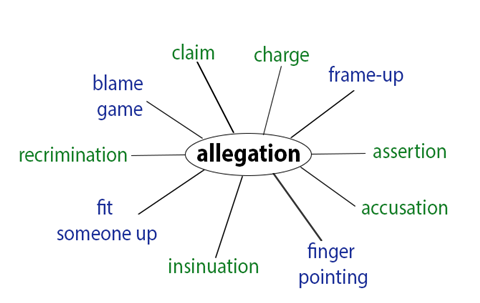
Rather than teaching students how to express something with one word, think about having them build up sets of synonyms. Then learners will know how to create their own word banks of linking words that have similar meanings so they can express themselves in a variety of ways right from the start.
Four paraphrasing activities
As every teacher knows, having a toolkit of ideas keeps things fresh in the classroom. So how can we encourage our students to use paraphrasing strategies in the classroom on an ongoing basis? One way to achieve this is to include learner-centred ice-breakers to target this skill. Here are four ice-breakers that you might want to try or adapt for your learners.
Social Butterfly (speaking)
This ice-breaker focuses on paraphrasing when answering questions at an imaginary party. Elicit a few questions from your learners and write down a list of question prompts they need to ask people (e.g. …name? …age? …hobbies? …free time? …last holiday? etc). Then tell learners that they must go and mingle. Encourage them to be ’social butterflies’ and speak to as many people as possible in the allotted time (five minutes). When they mingle, they must take turns asking and answering the questions. Let learners know that whenever someone answers a question, they must say either ‘ Pardon? ’ or ‘ Sorry? ’ to prompt their partner to rephrase what they have said.
You might want to write one or two examples up on the board. For example,
What’s your name?
My name ’s Kasia.
I’m called Kasia.
What do you like doing in your free time?
I usually go swimming or visit my friends .
I like going for a swim or hanging out with my mates .
To create a party-like environment, you could play music while learners complete the task. While the activity is taking place, monitor and record good examples of paraphrasing, then go over them as a whole group.
Full Picture (reading & speaking)
To avoid having this jigsaw reading task become a detailed reading task, text selection is essential for this five-minute ice-breaker. Choose a brief, three-paragraph text that has a clear beginning, middle and end – a text about a sequence of events, for example, works well for this type of task. Then place learners into groups of three and give each student a different paragraph. If possible, put each paragraph on different colour card. Give the class one minute to read their paragraphs without writing down any notes. When time’s up, they must place their texts face down. For the next three minutes, each teammate has about a minute to tell their team what their paragraph said, so they can decide on the order of the paragraphs. For the final minute, ask teams to give reasons for their decisions. This will encourage learners to further paraphrase their texts before you, finally, ask teams to turn the texts over and check if they figured out the correct order.
Back to the Board (listening & speaking)
Back to the Board is an ice-breaker that can be adapted for all ages and levels and is an excellent student-centred approach to revising vocabulary by paraphrasing key words. To set this task up, you need to divide the class into two teams and place two chairs at the front of the class facing away from the whiteboard or Smartboard. You’ll also need a list of vocabulary learnt in previous sessions and a scoreboard. Nominate one person from each team to sit with their backs to the board. Once they are seated, emphasise that they mustn’t peek! Then, write one word from your list on the board. Ask the class to describe the word on the board. The first person with their backs to the board to shout out the correct word earns a point for their team. Have a new pair come up, and keep repeating the process until you complete the list of words. The team with the most points wins.
It’s always a good idea to demonstrate at least one example before nominating the first two students:
- Write the word on the whiteboard: e.g., houseboat
- Demonstrate an explanation without saying ‘house’ or ‘boat’: It’s an unusual type of home that floats. You can see this kind of home on canals or lakes.
Message Trail (writing)
A very quick writing task to encourage learners to paraphrase when they write is called Message Trail. This ice-breaker is easy to prepare – all you need are four sentences targeting vocabulary and structures previously learnt in class. Put learners into groups of four and give each person a piece of paper that has a different sentence. Tell learners they need to change one word in the message so that it still has the same meaning then pass the message to the person on their left. Keep passing and rephrasing the messages until the teams run out of ideas of how to paraphrase the sentences. Finally, have each team read out their final sentence to compare the types of paraphrases they came up with. The team with the most paraphrases that still reflects the meaning of the first sentence wins.
It’s also a good idea to do one example with the class. For example:
I rarely have enough time to clean my room.
I hardly ever have enough time to clean my room .
I hardly ever have enough time to clean my bedroom .
I hardly ever have time to clean my bedroom.
Only on rare occasions do I have time to clean my bedroom.
Only on rare occasions do I have time to tidy up my bedroom.
Paraphrasing for exam success
You’ll be doing your learners a great service by reinforcing how to paraphrase in the classroom, as it is a skill that is needed for exams from A2 onwards. For speaking assessments, for example, encouraging learners to paraphrase by rephrasing statements, questions or ideas, and saying them in a different way, results in higher marks.
Many listening and reading exams often have questions that test listening or reading for detailed meaning, gist, feelings, attitudes and opinions, all of which require learners to decode paraphrases. In order to achieve this, learners need to piece together the different paraphrases they hear or read in order to arrive at the correct answer. So even at the lower end of the CEFR scale, paraphrasing comes into play.
Writing exams generally award lower marks if learners simply lift vocabulary off the question paper rather than paraphrase the information provided to complete the task. For example, the new B1 Preliminary Part 1 Writing task requires learners to write an email in about 100 words using four note prompts in a situational email. Learners should always aim to rephrase the prompts and the language that appears in the email in order to receive higher marks. Importantly, they need to identify what type of information they need to write about, rephrase information in the email and add their own ideas.
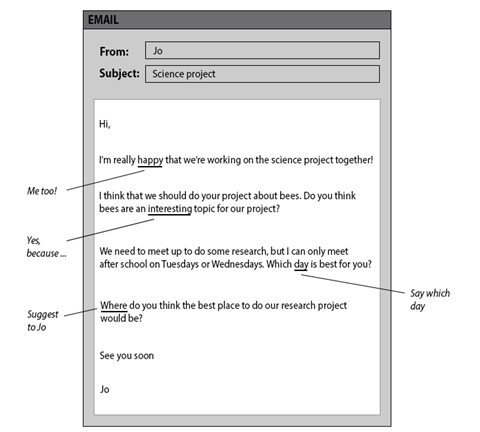
For example, learners should avoid copying large segments of text that appear in the email like this:
I’m really happy we’re working on the science project together too!
Encourage them to paraphrase like this:
I’m so glad we’re going to be partners for the science project!
Hopefully, by developing your learners’ ability to paraphrase in the classroom, they’ll have the skill and confidence to perform well in exams. However, the real icing on the cake is for learners to become self-aware of the power of paraphrasing and how it can support their language learning journey.
About the author

Judy Alden originally comes from Vancouver and has over 18 years’ experience teaching in South East Asia and Europe. She combines being a freelance assessment writer with delivering teacher training workshops, while also writing ELT course books and materials for international publishers.
As an assessment writer based in the UK, she often gets asked to produce listening assessments varying between British and American English. Judy has also written young learner assessment materials for the United Arab Emirates Ministry of Education.
- advancing learning

Advancing Learning: The challenges of speaking

Advancing Learning: Confessions from an obsessive language learner: what I have learnt from continually studying languages for 32 years

Advancing Learning: Developing real conversation skills

Advancing Learning: Does anyone really need to use a dictionary?

Advancing Learning: EMI: English as a medium of instruction

Advancing Learning: The Fifth Skill – ‘viewing’

Advancing Learning: Five strategies to help students cultivate a growth mindset

Advancing Learning: Gamification

Advancing Learning: Global Citizenship Education in the ELT classroom

Advancing Learning: Guilt-free teaching – how your students learn more when you plan less

Advancing Learning: Helping very young learners improve their collaboration skills

Advancing Learning: How to approach essay writing

Advancing Learning: Long live 'Life Skills'!

Advancing Learning: Making blended learning useful and effective

Advancing Learning: Moving towards learning-friendly teaching

Advancing Learning: Multisensory learning in the inclusive classroom

Advancing Learning: Online Language Teacher Education

Advancing Learning: A practical guide to online professional development

Advancing Learning: The secrets of using learning routines with young children

Advancing Learning: Teaching mediation

Advancing Learning: Top tips for managing your pre-primary classroom
Related articles.

Power Relationships: Adult (B2)—Education for Sustainable Development and Citizenship Programme
This lesson can help your students identify real-world examples of the effects of power relationships and privilege.

Empathy: Secondary (B1)—Education for Sustainable Development and Citizenship Programme
This lesson can help your students show empathy with another’s perspective of the world.

Education for Sustainable Development and Citizenship Secondary (B1): Power Relationships
Help your students identify power relationships and different forms of power.
No comments yet
Only registered users can comment on this article., more from advancing learning.
By Kateryna Protsenko
What is ‘conversation’ and how can teachers improve students’ conversation skills? This article, by Kateryna Protsenko, looks at the different ways to improve this skill.
By Liz McMahon
What are the challenges of teaching curriculum subjects through English at Primary level? Liz McMahon looks at some of the issues.
By Russell Stannard
Russell Stannard details how his own language learning has given him insights into how to better teach his students.
Join onestopenglish today
With more than 700,000 registered users in over 100 countries around the world, Onestopenglish is the number one resource site for English language teachers, providing access to thousands of resources, including lesson plans, worksheets, audio, video and flashcards.
- Connect with us on Facebook
- Connect with us on Twitter
- Connect with us on Youtube
Onestopenglish is a teacher resource site, part of Macmillan Education, one of the world’s leading publishers of English language teaching materials.
- Privacy Policy
- Cookie policy
- Manage cookies
©Macmillan Education Limited 2023. Company number: 1755588 VAT number: 199440621
Site powered by Webvision Cloud

Paraphrasing Techniques : Enhancing Pedagogy for Educators
In the realm of pedagogy, the concept of paraphrasing typically conjures thoughts of its utility in students’ academic endeavors.
However, what often remains less explored is the profound potential of paraphrasing techniques for educators themselves.
This can be achieved through the judicious application of paraphrasing techniques facilitated by modern paraphrasing tools.
So without further ado, let’s get into it.
Ways Teachers Can Improve Pedagogy By Utilizing Paraphrasing Methods
What is paraphrasing.
Paraphrasing is expressing a text or a passage in a new way while retaining the meaning of the original text. Essentially, it means changing words, shuffling sentence structure, and use of alternate voices. It is considered one of the best practices for teaching and overall, in the world of writing.
Improved Communication With Students
This is a sad one but not any teacher’s fault I believe. A teacher believes their way of teaching is the best as it’s easier to understand and explain to them. The students may think otherwise.
Growing up, I remember the kids rooting hard against the teacher who failed to explain tricky concepts to us. I feel ashamed now but I was just a kid and those were different times. Present time allows teachers to get help from any online paraphrasing tool to help them prepare lectures.
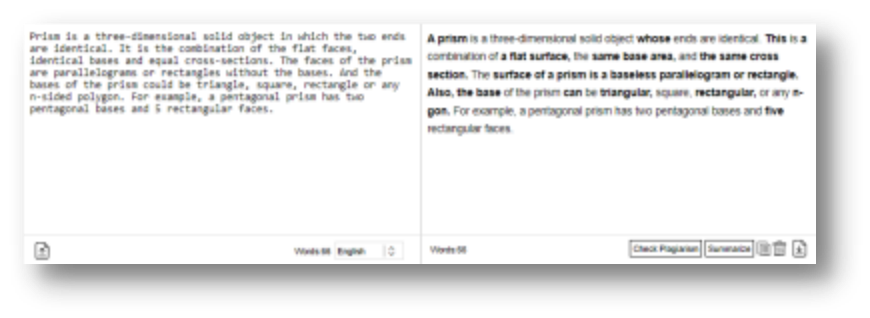
Just look at how the tool effortlessly explains the same thing but in a less jargon way. It can make those tenacious teachers finally realize the flaws in their methods by introducing new and easier ways of elaborating tough concepts.
Increased Class Engagement
The best teachers, in my opinion, are those who are actively engaging their classrooms and not just reading paragraphs from a book for the sake of it. Those teachers have my respect. It’s one thing to paraphrase your lectures for teaching but another when you ask your students to do it.
The greatest learning experiences involve active participation from all the students and it’s the teacher’s job to make everyone participate. Paraphrasing enables students to break out of their typical thinking molds and look at the problem more critically, something even the best textbooks can fail to emulate.
Designing Outlines
When planning the lectures, teachers can create outlines that are much easier to give lectures from. Typically, the teachers prepare the lecture and then write down the key points to make it easier to connect point to point during the lecture.
It would be nice if the outline had clarity and was easy to read. Don’t want to be a deer in headlights when giving lectures. Don’t want to give students another reason to make fun of teachers.
To avoid this, the teachers can use paraphrasing techniques to craft outlines that are silky smooth to read off of and give lectures from.
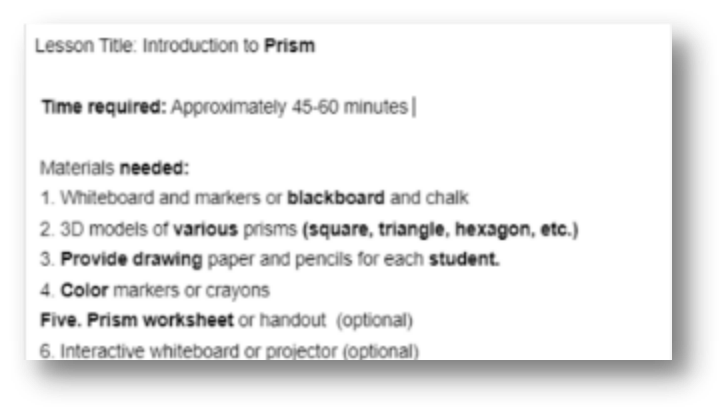
By Handing Out Paraphrasing Assignments To Students
This may seem like a cop-out point but let me explain. If the teachers are going to be handing out paraphrasing assignments, then you can assume they already know their answers.
Meaning they worked on the assignments and in turn improved their work. They have new ideas for explaining the same topics and it gives them an edge in teaching. The same logic can be applied to students. Paraphrasing exercises open up their minds to the possibility of critical thinking skills and vocabulary improvement.
Students learning new things and improving in their academics is in fact, the direct result of teachers improving their work.
The problem with old-generation teachers (I’m resisting the urge to say, boomers) is that respectfully, they don’t adapt. They don’t want to adapt. They feel they know everything which is true to a certain extent.
I also believe that they should always be highly regarded but how far can you stretch that sentiment without a teacher’s willingness to improve their work? At least, the new-gen teachers are far more willing to take the bold step of improving their work.
Paraphrasing techniques used in paraphrasing tools are a way of improving their work by a margin. All it requires is some willpower from the teacher’s end.
Recommended:
- How to Teach a Child to Write their Name
- How to Teach Sight Words to Struggling Readers
- 20 Classic Quick Games to Play in the Classroom
Rubina Numan
Rubina Numan, a seasoned Instructional Designer, is renowned for innovative, learner-centered experiences merging pedagogy with technology. With a BSc (IDT) from the University of Huddersfield , she holds over a decade of experience collaborating with diverse educational realms.
Leave a Comment Cancel reply
Save my name, email, and website in this browser for the next time I comment.

Musing From The Middle School
Summarizing, Paraphrasing, and Quoting
September 21, 2014 by jwyks 12 Comments
This year, I decided to teach this skill over a few days at the beginning of the year. I’ve never taught it like this before. I usually wait until I move into nonfiction and argument writing and then I mention the difference in the three, but I never teach it as its own lesson. However, this year I thought maybe knowing how to do each of these early on would help as we start working on answering open-ended questions.

Next, I had the kids read some short articles (I used some old Time for Kids magazines) and answer some simple, “right there” questions using either a quote, summary, or paraphrase to support their thinking. I am hoping that teaching this strategy early on will pay off. Often, I have students (usually my struggling learners) who will copy an entire paragraph from a text because they think they are supporting their answer. Typically, they don’t use transitions and their answers come out disjointed and confusing and LONG!
Do you teach this skill as its own lesson? How’s it work for you?
Happy Teaching!!
Reader Interactions
July 21, 2015 at 8:57 am
This comment has been removed by the author.
November 13, 2015 at 5:54 am
July 5, 2016 at 7:26 am
September 5, 2016 at 8:27 am
Thanks! I will definitly try it with my little students! They like colorful and bright things, so I think it is a great way to teach them about summarizing, paraphrasing, and quoting. Also, I have a question for you! How do I teach my students that services like this one aren't good for them?
January 23, 2017 at 12:07 pm
Well thought content impressed me! I am glad to check out sharing information and accordingly meet with the demands paraphrase mla format
July 25, 2017 at 4:57 am
Microsoft Office and IE integration. You can integrate Summarizer into your favorite applications and summarize texts with one click without switching the windows. more
July 25, 2017 at 11:37 am
Key study skills for summarizing are skimming and scanning. Honing these skills will take practice but with the right strategies and orientation you will be summarizing quickly and effectively in no time. homepage
August 18, 2017 at 4:31 am
I have helped graduate students edit essays, analysis papers, dissertations, and alternative graduate-level papers. the foremost common drawback I actually have found once writing graduate papers is that the lack of transitions. homepage
January 3, 2018 at 3:43 pm
Thanks for sharing.
October 14, 2018 at 12:55 am
October 14, 2018 at 12:56 am
very informative
Leave a Reply Cancel reply
Your email address will not be published. Required fields are marked *
Save my name, email, and website in this browser for the next time I comment.

- Back-to-School
- Classroom Library
- Article of the Week
- Engagement Strategies
- Mentor Texts
- Writer’s Notebook
Let’s Connect
Paraphrasing to Support Reading Comprehension
October 12, 2021 kaia cunningham, strategies to support vocabulary and reading comprehension.
I love stories. I love getting lost in a narrative and using the magic of words to imagine another place, time, and life. It can be so powerful, and it’s an experience that I love sharing with my students.
Vocabulary knowledge and background information are the cornerstones of reading comprehension. They are the necessary foundations on which understanding is built and a mental movie is created. That said, vocabulary knowledge and background information can present a roadblock to reading comprehension for student with dyslexia, who can often present with sizable gaps that thwart their path to understanding. Students with dyslexia read less than their peers and, thus, are exposed to fewer words. As a result, fewer words become a part of their vocabulary. This limited vocabulary can impact their ability to recall parts of history, geography, or political events that often set the stage for the literature that we read in school.
Reflect back on the first pages of To Kill a Mockingbird . They make many references to American history and relevant locations in the American south: Andrew Jackson, “Creeks up the creek,” Battle of Hastings, Mobile, Montgomery, and the list goes on. Imagine trying to make a mental movie of the setting of this novel if you thought Andrew Jackson was not a prominent and controversial American president, but a character in the novel? Or if you mistook Mobile for Mobil and assumed the text was referring to a gas station not a city in Alabama? It would be a muddled setting at best and it would be challenging to be drawn into a story where the scene didn’t make any sense.
It is important to note that a limited vocabulary is not the single story of our students; I have been corrected more than once for making the assumption that students with dyslexia don’t like reading and that laborious reading does not equate to a disinterest in learning or stories. Our older students who are diagnosed with dyslexia often crave these complicated texts with big moral questions. And herein lies the problem: high and school and middle school students with dyslexia or other SLDs often have the cognitive capacity and desire to understand complex texts like To Kill a Mockingbird , The Bell Jar , and other widely anthologized texts, but they are often tripped up by a lack of memory or exposure to important words and concepts.
So what do we do? What is an effective strategy for students to be able to gain entry to these interesting and complex texts? This is a problem that I have grappled with for nearly 20 years of teaching. It is impossible to make sure that every word, concept, and reference is explained and taught in novels. When I have attempted that, it has been a spectacular failure: the pacing was excruciating and the excitement of the story was lost.
A solution can be found in a simple study skills strategy: paraphrasing. The skill of paraphrasing asks students to take a passage and restate it in their own words, making sure to keep all the essential information intact. To do this with fidelity, students must know the meaning of all the words in the given passage: the figurative language, all the references and concepts. Missing one of these essential pieces can result in the student missing essential pieces of information in the passage or walking away with only the gist of the meaning.
For example, in the first few pages of The Bell Jar , the protagonist, Esther says: “Only I wasn’t steering anything, not even myself. I just bumped from my hotel to work and to parties and from parties to my hotel and back to work like a numb trolley bus. I guess I should have been excited the way most other girls were, but I couldn’t get myself to react. I felt very still and very empty, the way the eye of a tornado must feel moving dully along in the middle of the surrounding hullabaloo” ( Plath p. 3 ).
At first glance, there are only a few words to which an 11th grade student wouldn’t at least have been exposed, but when asked what the word trolley means in this context, a student must examine how the figurative language explains Esther’s feelings. Engaging students in this wide and deep language study can inspire authentic conversations and discussions about words and their multiple meanings and roles, as well as give a solid foundation to explore Esther’s emotional state. Paraphrasing passages frequently and early in the reading of a text can also help students narrow their focus when reading. Thinking back to the Bell Jar , knowing early on that Esther is feeling numb, that she feels that she is moving without thinking, and that, most importantly, she feels as though she isn’t reacting to a situation the way she believes she should can help explain and frame many of her later decisions within the novel.
Not only does this type of skill work provide a framework for understanding, but when students are asked to put the events and meaning of a quote into their own words, they are also working on written expression. This is a lucky consequence, as not only is their understanding of the novel improved, but also their ability to write clearly about complicated information.
As with all language-based education, it is important to coach students through the process. Tell them what it means to paraphrase and why it’s an effective tool to boost comprehension.
Check out the attachment, which provides a sample of how this strategy can be used in the high school or middle school classroom.
Strategies to Download
Recommended for you.

Oct 28, 2021
Handwriting and Literacy Development

Nov 29, 2021
The Simple View of Reading

Oct 8, 2021
What is Dyslexia?
Check out our blog.
Learn about our new updated blog format that will combine our monthly newsletter and Free Teaching Strategies into one resource!
Check Out the New Website Shop!

Novels & Picture Books

Anchor Charts

- Informational Texts
- Literacy Anchor Charts
- Reading Skills
Summarizing, Paraphrasing, and Quoting Texts
By Mary Montero
Share This Post:
- Facebook Share
- Twitter Share
- Pinterest Share
- Email Share
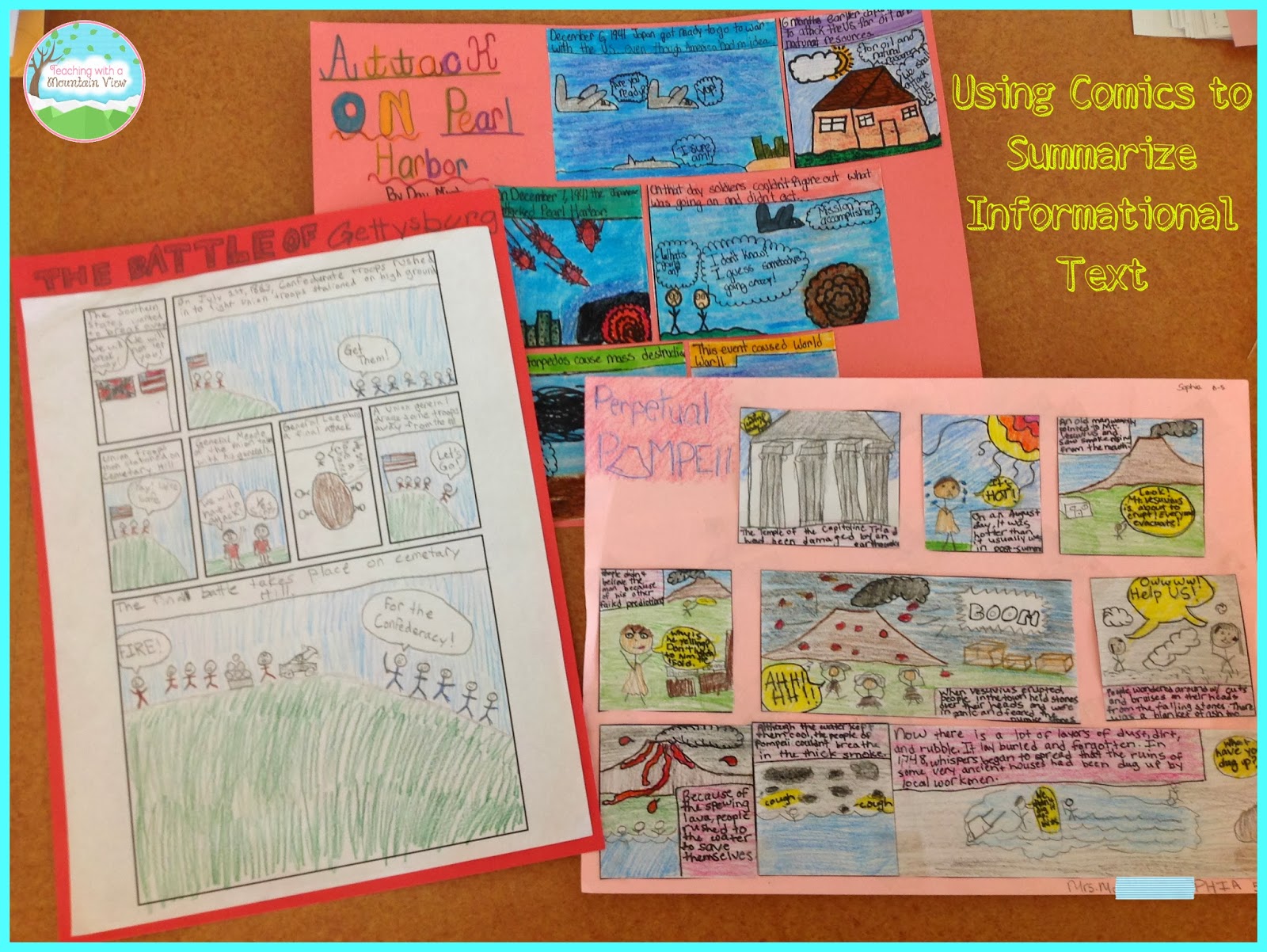
We are SO close to being done with our nonfiction unit, and I’m looking forward to jumping back in to novel studies. My students are slowly growing to love (okay, maybe like is still a better word) informational text, and that was truly one of my main goals in all of this.
Last week, we did a brief review of the difference between summarizing, paraphrasing, and quoting texts. I should have done this a long time ago! I often see it taught in the context of research, but when I started seeing summaries that used direct quotes or lines from the text, I knew it was time. It’s also a huge skill for 5th graders to be able to paraphrase well, so I decided it was worth taking the time to do. Oh, and the fact that standardized testing is coming in less than month was excellent incentive as well.
First, I used an idea that I got from Teaching in Room 6 about summarizing nonfiction texts with comic strips. I LOVED this idea, and you should really read her original post. She does a great job of explaining it, and her kids actually used the Comic Creator software to make really neat and authentic-looking comics!

I began by having my students select a book from our library focusing on an event in history. They had to really focus in on one event that only spanned the course of about a day. So, if they chose a major war, they had to pick one battle.
Then, they wrote summaries of their events. Next, I had them transfer their summaries into comics. They had to use text and dialogue to tell the story and include all of the information their summary had (without just rewriting, of course).

They came out so nice, and they all agreed that it was such a fun way to practice summarizing!
Update: I now have an entire post on teaching summarizing! Click here to read more about summarizing, too.
Then, we made a foldable and anchor chart to review the differences between paraphrasing, summarizing, and quoting. Most of the students knew what quoting was but had forgotten how to do it with integrity (using quotation marks and referencing the author).
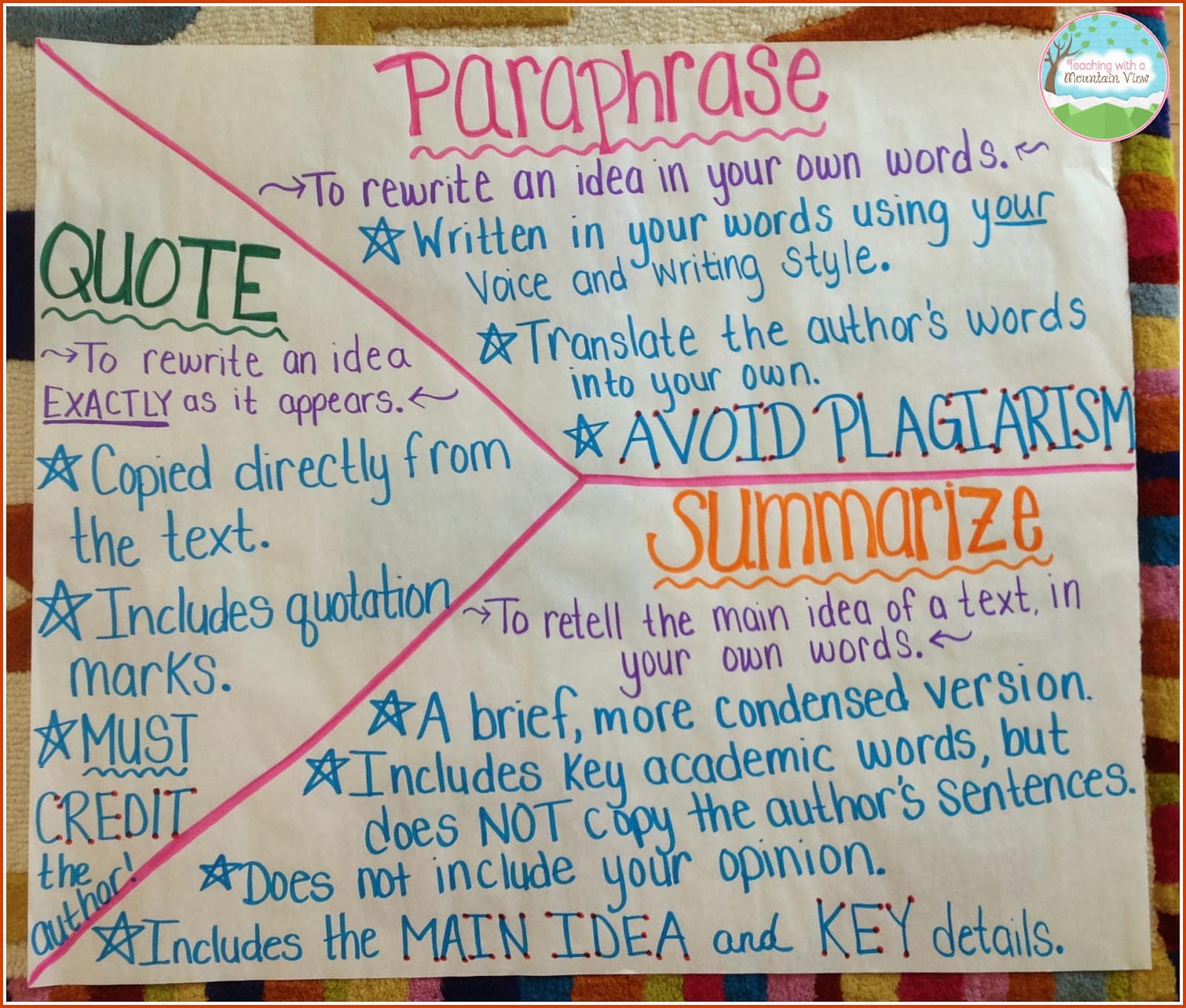
I included a definition of each then some key ideas about each.
Update: Here’s another version, and you can download the template to make your own HERE . The notebook template is also included in this free file.
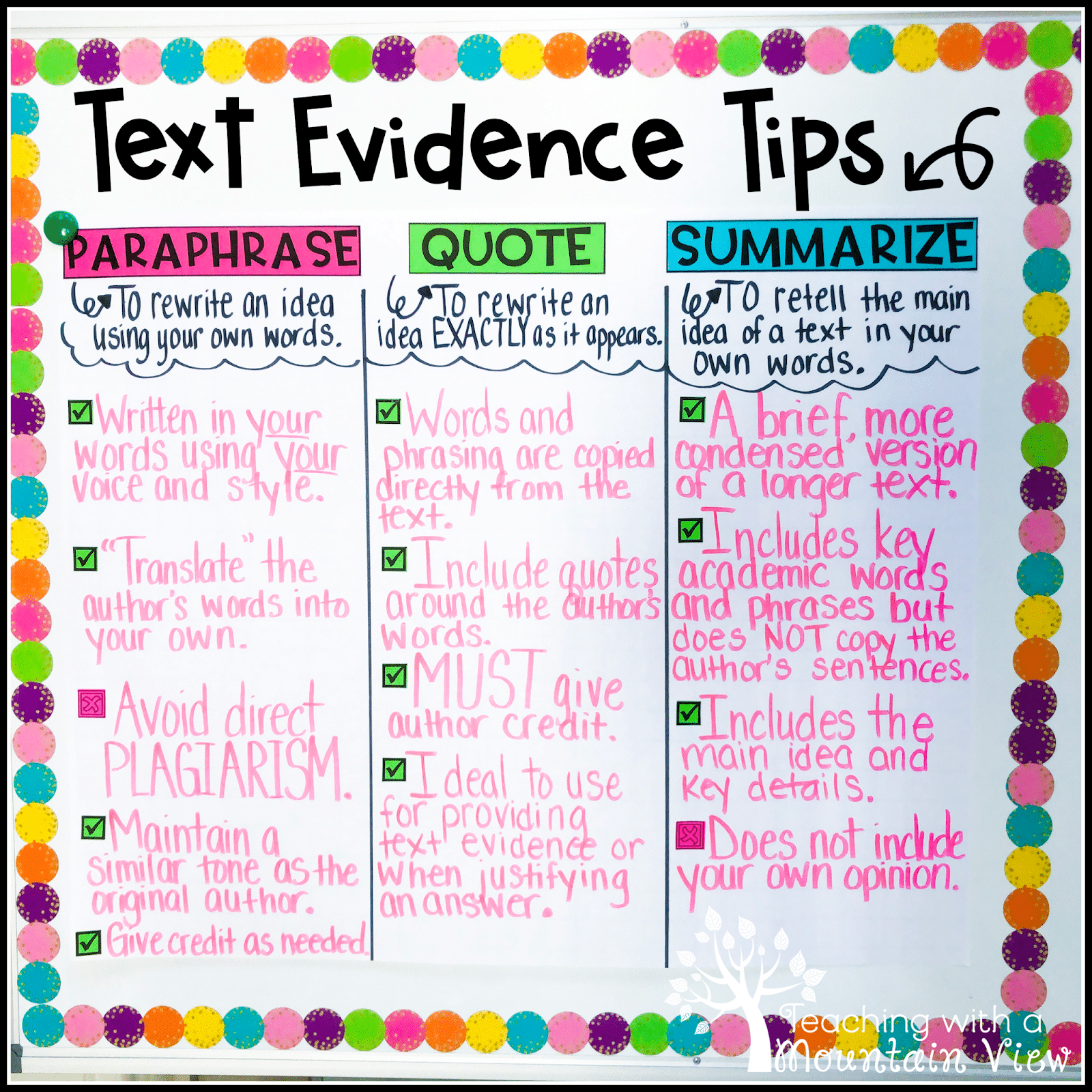
They copied the key ideas on the top flap of their foldable. Then I created some summarizing task cards to help them see the difference between the three different types of rewriting and retelling.
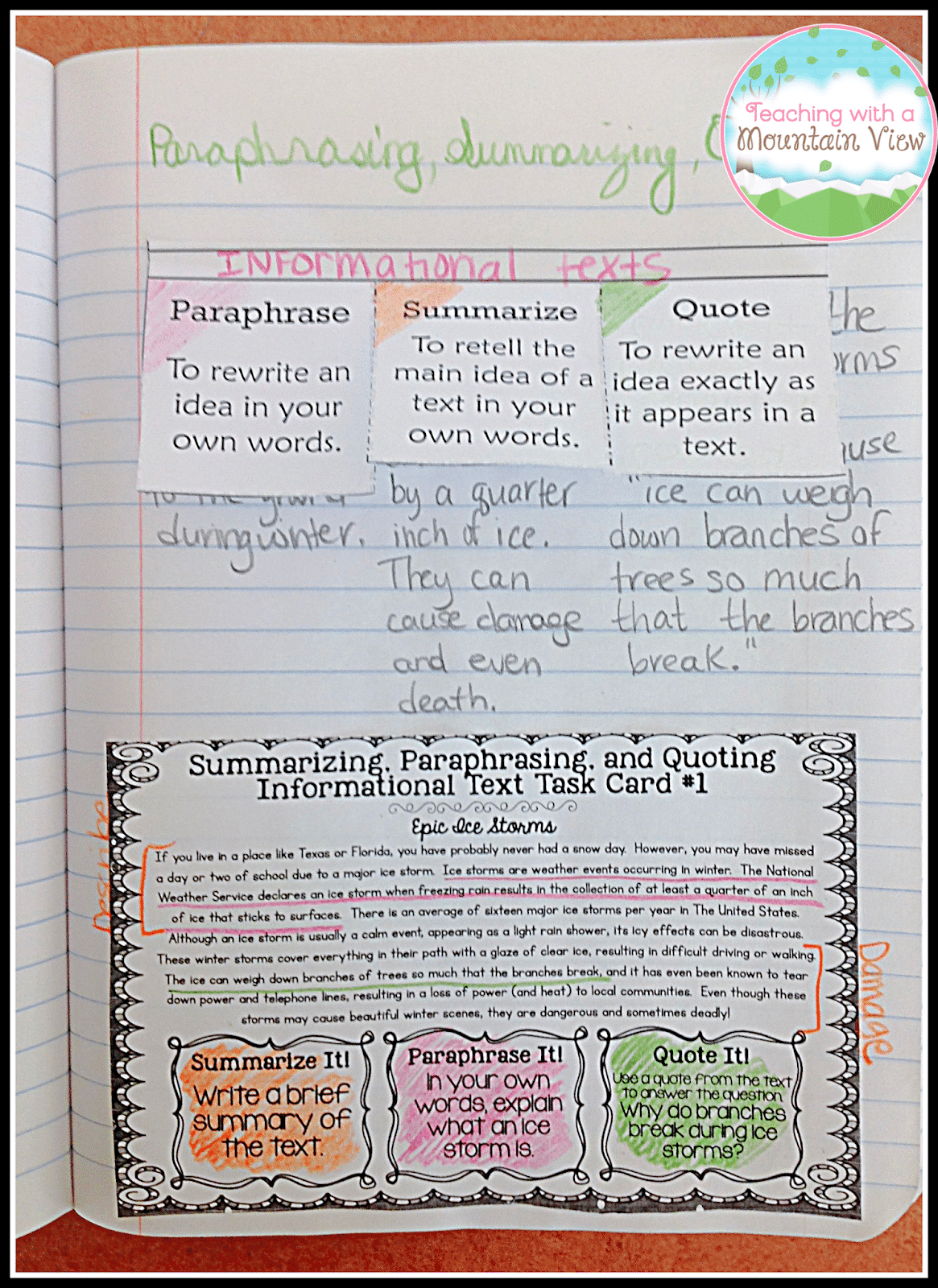
I made a copy of the first card for each student and they glued it on the same page as their foldable. Under each section of the foldable, they did the task under the flap so that they could see the different between paraphrasing, summarizing, and quoting using the same text. We also underlined and color-coded their responses from the text. This week, they are working on one card per day as part of their reading warm up. So far, they have been incredibly effective, and I know it will make a difference in their written reading responses. It will also be great to have this under their belt for research in the future.
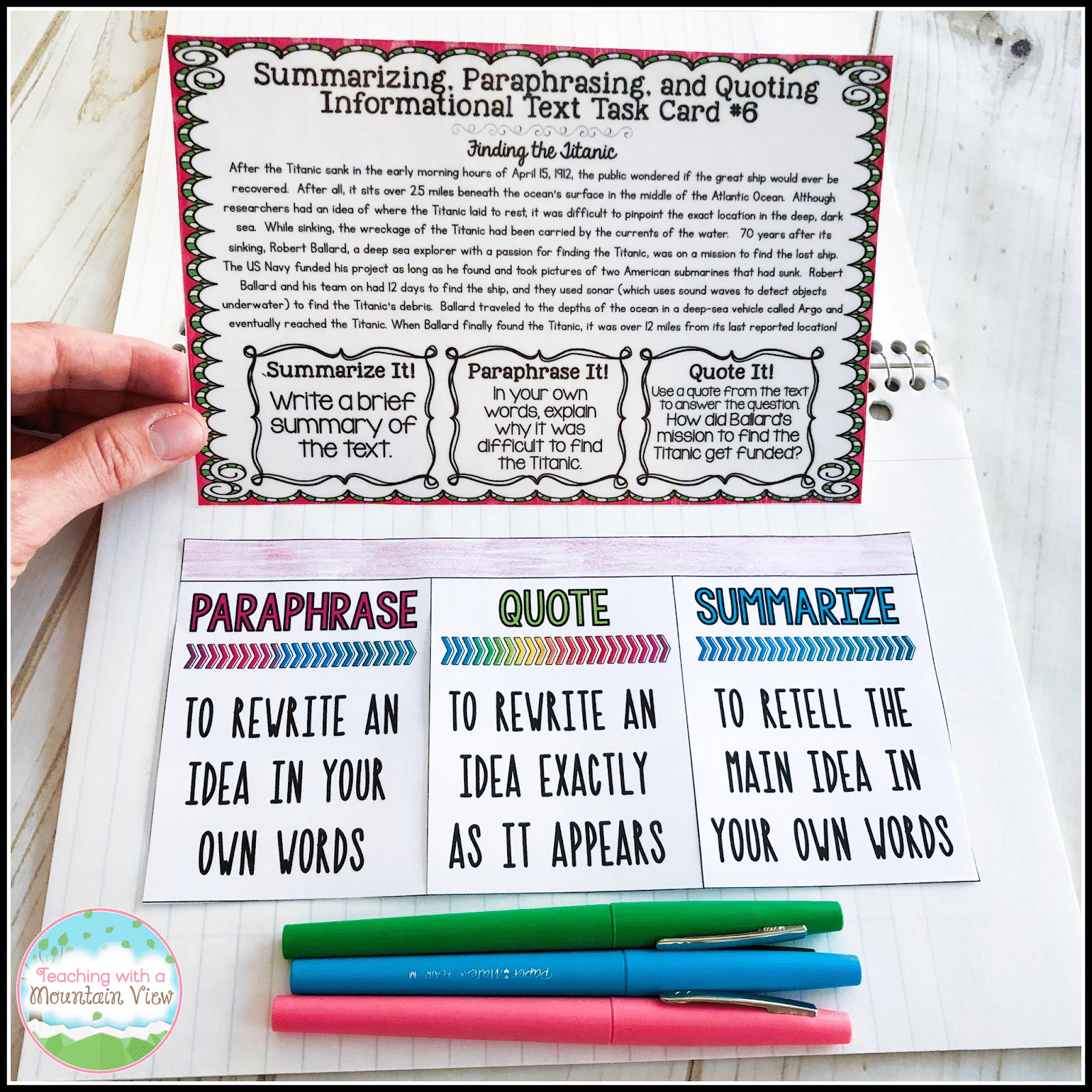
If you are interested in the summarizing task cards, you can buy them HERE . They also include a digital option to use with your student devices!
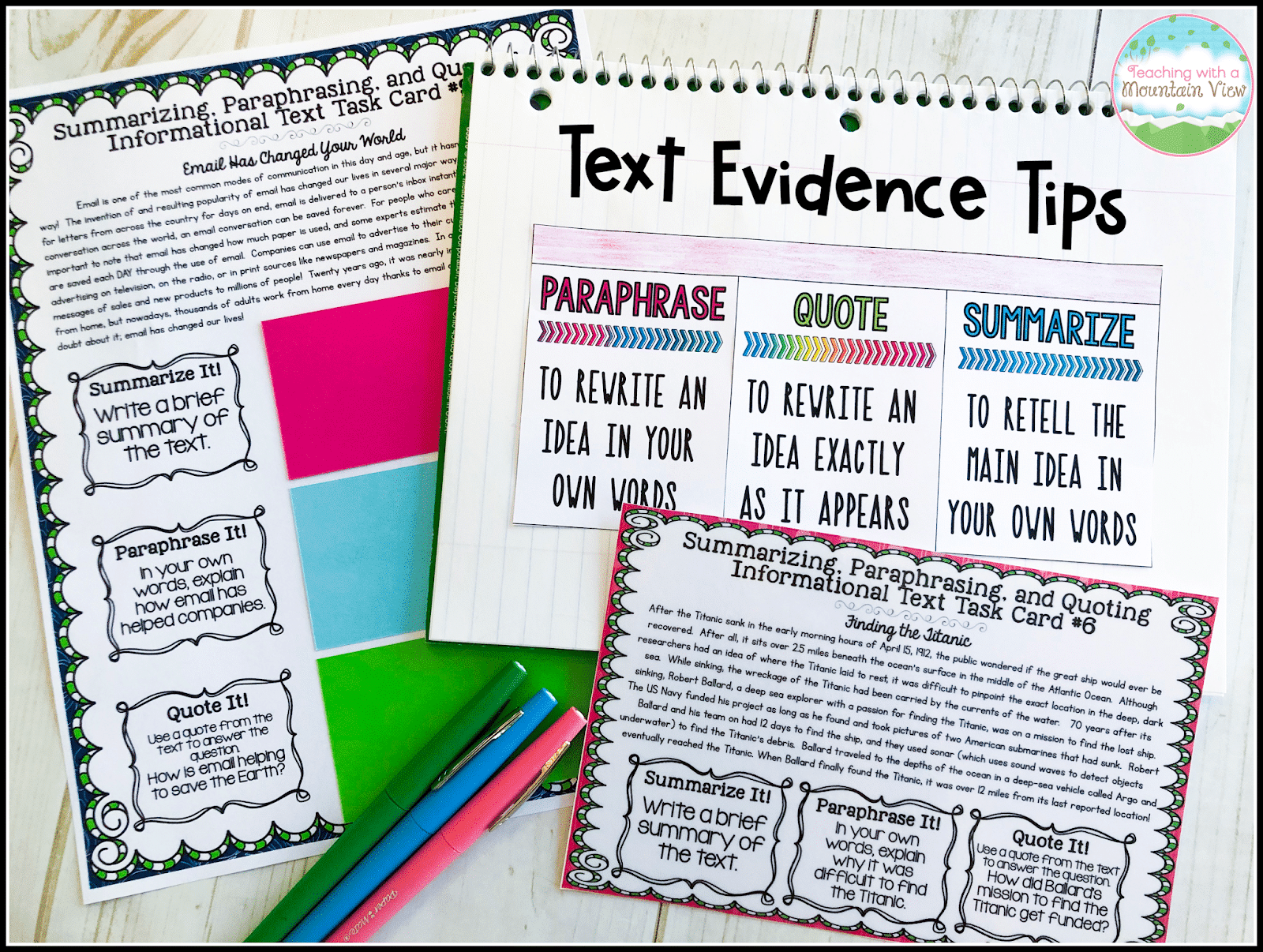
Working on just one skill at a time? This summarizing, paraphrasing, and quoting BUNDLE is a good starting place when working with shorter paragraphs. Each of these task card sets includes 32 high-interest nonfiction reading passages and a single prompt to summarize, paraphrase, or make a direct quote.
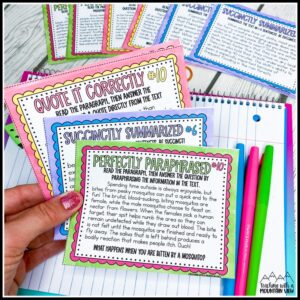
Have a happy week!
Mary Montero
I’m so glad you are here. I’m a current gifted and talented teacher in a small town in Colorado, and I’ve been in education since 2009. My passion (other than my family and cookies) is for making teachers’ lives easier and classrooms more engaging.
You might also like…

Leave a Reply Cancel reply
Your email address will not be published. Required fields are marked *
14 Comments
I absolutely love all your products! This is such a great idea for getting students to really pick up on the differences between all three! I'm going to have to look into this for next year, but this year it may make a great RTI or reteaching lesson for some of my kiddos that still need help!
We're getting ready to use your Text Structures task cards right now to reteach text structures in small groups!
Thanks for sharing and producing such great products/ideas! Amanda My Shoe String Life
In writing, it is best to focus your attention in developing your paragraphs more. In that case, you have to be aware about its structure and how ideas are passed from sentence to sentence and to the next paragraph in your content. paraphrase vs summary
Presenting the ideas and information you have read in your own words – is an important academic skill. By translating content from your research into your own words, you demonstrate to your reader that you've understood and are able to convey this content. http://www.paraphrasingmatters.com Paraphrasing Services
A few computer software methods may help writers involving online publications to confirm to the inspiration involving content articles, along with with this volume methods for instance Copyscape usually are best paraphrase tool.
If you are having problems rewriting your paper, you can always have an expert to do it for you. There are several automatic paraphrase online tool services but you can never be too sure that they will be able to deliver accurate paraphrasing results.
That got it. Thanks so much. Keep up the amazing work! paraphrase tool
This comment has been removed by the author.
Summarizing about the content and about paraphrasing the context some of the little changes you have to made while you going to decide for your article. rephrasing tool
Thanks for sharing your reviews about paraphrasing help Services which will sure help me to improve my paraphrasing help in its best way and making its quality best
Customers want two things from your CSR (Customer Service Representative): To know that they care and that there are options to solve the problem. There are a number of ways a CSR shows that they care. Tone of voice and listening are the most important. paraphrasing service uk
Its even considered to be so hard when you are not in full context and the mood to show off and write things onto your own wording but with sufficient help this could even be more better. paraphrase tool
Customers need 2 things from your CSR (Customer Service Representative): to understand that they care which there area unit choices to unravel the matter. There area unit variety of how a CSR shows that they care. Tone of voice and listening area unit the foremost vital. paraphrasing examples
michael kors outlet , http://www.michaelkorsoutletcanada.in.net san antonio spurs jerseys lululemon cheap jordans , http://www.jordan-shoes.us.com kate spade handbags nike huarache coach outlet online yoga pants , http://www.yogapants.us.com the north face outlet store pandora charms air max 2014 burberry outlet online michael kors outlet , http://www.michaelkorsoutletonlinstore.us.com beats headphones babyliss pro instyler prada shoes kate spade outlet tory burch outlet lacoste shirts lebron james shoes stuart weitzman boots michael kors canada , http://www.michaelkorsoutletcanada.in.net babyliss oakley sunglasses , http://www.oakleysunglassescanada.com fred perry sale green bay packers jerseys coach outlet canada nike roshe run jordan 4 atlanta falcons jersey kate spade outlet vibram fivefingers salvatore ferragamo ferragamo shoes hollister clothing store swarovski jewelry asics running shoes michael kors uk outlet 0811maoqiuyun

©2023 Teaching With a Mountain View . All Rights Reserved | Designed by Ashley Hughes
Username or Email Address
Remember Me
Lost your password?
Review Cart
No products in the cart.
- Enroll & Pay
- Prospective Students
- Current Students
- Degree Programs
The Paraphrasing Strategy
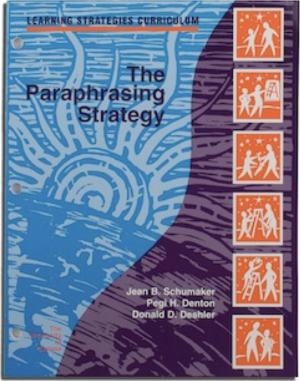
The Paraphrasing Strategy is designed to help students focus on the most important information in a passage and to improve students' recall of main ideas and specific facts. Students read short passages of materials, identify the main idea and details, and rephrase the content in their own words.
In research studies, students showed average gains of 35 percentage points in reading comprehension of grade-level materials after mastering the strategy.
This product is available through Edge Enterprises, Inc.
Please note that professional development, coaching, and infrastructure support are essential components to effective implementation of SIM instructional tools and interventions. It is highly recommended that you work with a SIM professional developer. See the SIM Event list for sessions or email [email protected] to learn more.
Author(s): Jean B. Schumaker, Pegi H. Denton, and Donald D. Deshler
Publication Info: University of Kansas, 1984
- Research on the Paraphrasing Strategy (.pdf)
- Strategram Vol. 3, No. 1 : Teaching the Paraphrasing Strategy to Younger Students (.pdf)
- Strategram Vol. 8, No. 4: Using Persuasion to Present the Paraphrasing Strategy - and A Sentence to help remember the Paraphrasing Mnemonic, Emmett Murray (.pdf)
- Strategram Vol. 8, No. 5: Strategy Sticker Reminder for the Generalization Stage of Paraphrasing and Sentence Writing (.pdf)
- Strategram Vol. 10, No. 1: Study shows benefits of Paraphrasing Strategy in general ed middle school classrooms (.pdf)
- Strategram Vol. 12, No. 5, May, 2000: Tips for teaching paraphrasing, Gwen Berry (.pdf)
- Strategram Vol. 13, No.1: An Activity to introduce Main Idea and Details, Margaret Carmean (.pdf)
- Strategram Vol. 14, No. 3: Recommended reading: Passages for Paraphrasing and Word ID (.pdf)
- Strategram Vol. 17, No. 5: Active Reading to support Paraphrasing Strategy instruction (.pdf)
RESEARCH ARTICLES
- Schumaker, J.B., Deshler, D.D., Woodruff, S.K., Hock, M.F., Bulgren, J.A., & Lenz, B.K. (2006). Reading strategy interventions: Can literacy outcomes be enhanced for at-risk adolescents? Teaching Exceptional Children, 38 (3), 64-68. In two studies, students who learned reading strategies outperformed students who did not.
- Oas, B.K., Schumaker, J.B., & Deshler, D.D. (1995). Learning strategies: Tools for learning to learn in middle and high schools. Secondary education and beyond: Providing opportunities for students with learning disabilities. Pittsburgh, PA: Learning Disabilities Association of America. This article uses student case descriptions to illustrate how a variety of learning strategies--including the Self-Advocacy Strategy, Sentence Writing Strategy, and Paraphrasing Strategy --might be implemented with students who experience an array of learning disabilities characteristics.
An accessible version of the documents on this site will be made available upon request. Please contact the KU CRL Professional Development Research Institute, at [email protected] to request the document be made available in an accessible format.
SIM Events (website)
SIM Informational Brochures (SIM Overview, CER, LS, Writing, Math, HOTR)
SIM Micro-credentials (website )
Printable KUCRL Order Forms (link)
Request Professional Learning (online form)
Shop the KU CRL Online Store (link)
Technology-Enhanced SIM Learning
At the CRL, we wish to support teachers instructing in varied teaching and learning environments.
Find more resources at:
Integrating SIM with Other Programs, Strategies, and Initiatives
Technology-Enhanced SIM™ Learning Strategy Instructional Delivery
Technology-Enhanced SIM™ Content Enhancement Routine Instructional Delivery
paraphrasing and summarizing practice
All Formats
Resource types, all resource types.
- Rating Count
- Price (Ascending)
- Price (Descending)
- Most Recent
Paraphrasing and summarizing practice
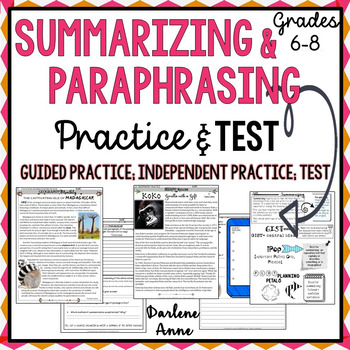
Summarizing & Paraphrasing Practice Worksheets and Test PRINT & DIGITAL

- Google Apps™

Summarizing & Paraphrasing Task Cards Practice Worksheets Passages & Questions
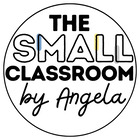
- Easel Activity
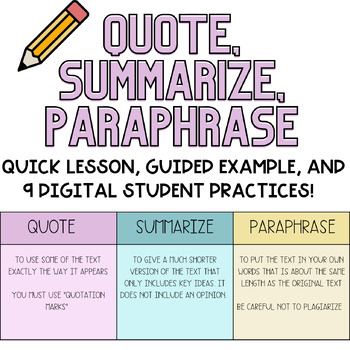
Quote, Summarize , Paraphrase - Digital Practice in Citing and Using Texts
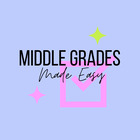
Paraphrasing and Summarizing Practice | Avoiding Plagiarism | PDF
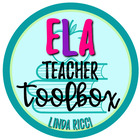
Summarizing and Paraphrasing Practice Worksheets, Activities, Anchor Charts


Paraphrase and Summarize Practice Activities | Avoiding Plagiarism | Digital
- Google Drive™ folder
- Easel Assessment
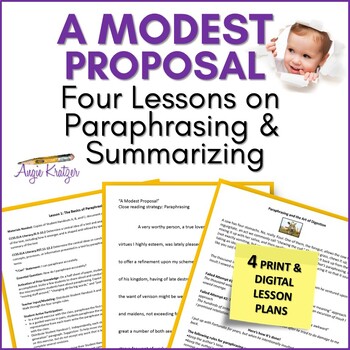
A Modest Proposal - Paraphrasing Practice - How to Summarize & Paraphrase

Types of Paragraphs - Handouts, Summarizing and Paraphrasing Lessons & Practice

Paraphrasing and Summarizing Practice Activity | Digital
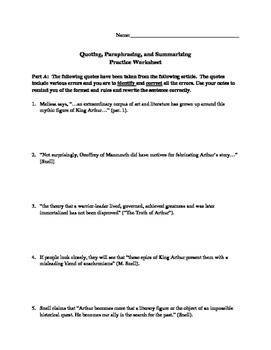
Quoting, Paraphrasing , and Summarizing Practice Worksheet

- Word Document File

Quote, Paraphrase and Summarize Example and Practice Worksheet

Paraphrasing and Summarizing Practice Activities

Paraphrasing and Summarizing Practice Lesson with Answer Key

- Google Slides™
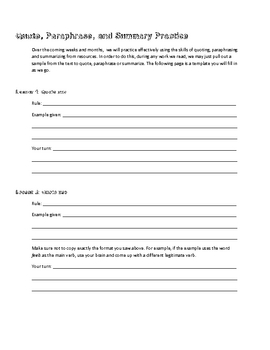
Worksheet for Quote, Paraphrase , and Summary Practice
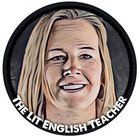
Paraphrase & Summary - Practice Sheets Plus PowerPoint Tutorial

Summarizing , Paraphrasing , and Quoting Practice

- Internet Activities

The Odyssey: Practice with Paraphrase and Summary

- Google Docs™
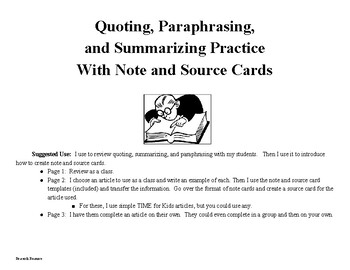
Quoting, paraphrasing , summarizing practice with source and note card practice .

Paraphrasing and Summarizing Practice

Paraphrase and Summary Practice (Research)

Paraphrasing and Summarizing Lessons for Nonfiction Reading

Summarizing & Paraphrasing PowerPoint, Notes, Worksheets, Test PRINT & DIGITAL
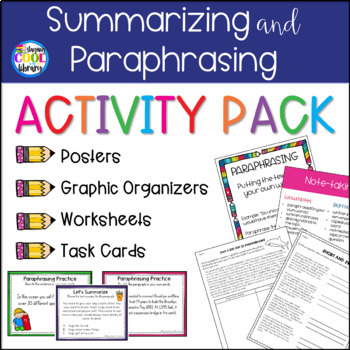
Summarizing and Paraphrasing Activities - Research Skills

Summarizing Paraphrasing and Quoting BUNDLE

- We're hiring
- Help & FAQ
- Privacy policy
- Student privacy
- Terms of service
- Tell us what you think
How to Use Paraphrase to Help English Language Learners
- Keren Perles
- Categories : Esl teaching tips & strategies for any grade level
- Tags : Teaching english as a second language
Why is Paraphrasing Important for ELLs?
It is important to use paraphrase to help English language learners because paraphrasing is one of the main methods that ELLs will be able to use to clarify that they have understood something correctly. For example, if a bank teller explains to an ELL the terms of a loan, the ELL should learn to clarify by saying, “So what I understand from what you’ve said is…” and to paraphrase what was heard. The same applies in many areas of life, including academic work, social settings, and professional situations.
Helping ELLs Paraphrase
Asking an English language learner to orally paraphrase what she has heard may put her on the spot, and she may be unable to paraphrase well. In order to show her how to paraphrase what she’s read, have her write down the paraphrase and then read it aloud. If she is having difficulty paraphrasing what she’s read, consider introducing her to a backwards web graphic organizer. This organizer looks like a web, with a large circle in the middle connected by lines to several smaller surrounding circles. The student can then insert details from what she’s read into the outer circles and then combine these details to fill in the central circle.
Paraphrasing Sentence Frames
Write a list of paraphrasing sentence frames on the board, and encourage English language learners to use them. The list might include any of the following:
- So what I heard you say was…
- From what you said, I understand that…
- Can you tell me if I understood correctly? It seems that you said…
- When you said…did you mean…?
Broken Telephone – A Paraphrasing Game
You can also play a game of broken telephone to help your students paraphrase. Have the class sit in a circle, and instruct every second student to tell a story – personal or otherwise – to the student on their right. When all of the pairs finish telling and hearing the stories, have the listeners to turn the student on their right and retell what they’ve heard. Continue until the story travels around the entire circle, and have the last listener of each story tell the story to the entire class. Ask the original teller of each story to explain if and how the story changed while going around the circle.
These activities use paraphrase to help English language learners communicate effectively with those around them. Encourage students to practice this skill over the course of the year, and praise those who do so spontaneously.
- Skip to primary navigation
- Skip to main content
- Skip to primary sidebar
How to Teach Paraphrasing to High School Students
Research Writing , Secondary Literacy , Writing
Paraphrasing is a skill that students often learn in elementary or middle school. However, it is important to teach paraphrasing to high school students as well. Paraphrasing is an important writing skill. It encourages students to expand their vocabulary and modify sentence styles. It also challenges them to read closely and analyze meaning.
Paraphrasing is also an essential skill to avoid plagiarism . As high school students begin researching and developing more complex ideas, it is important to clarify the difference between paraphrasing a sentence and plagiarizing an essay.
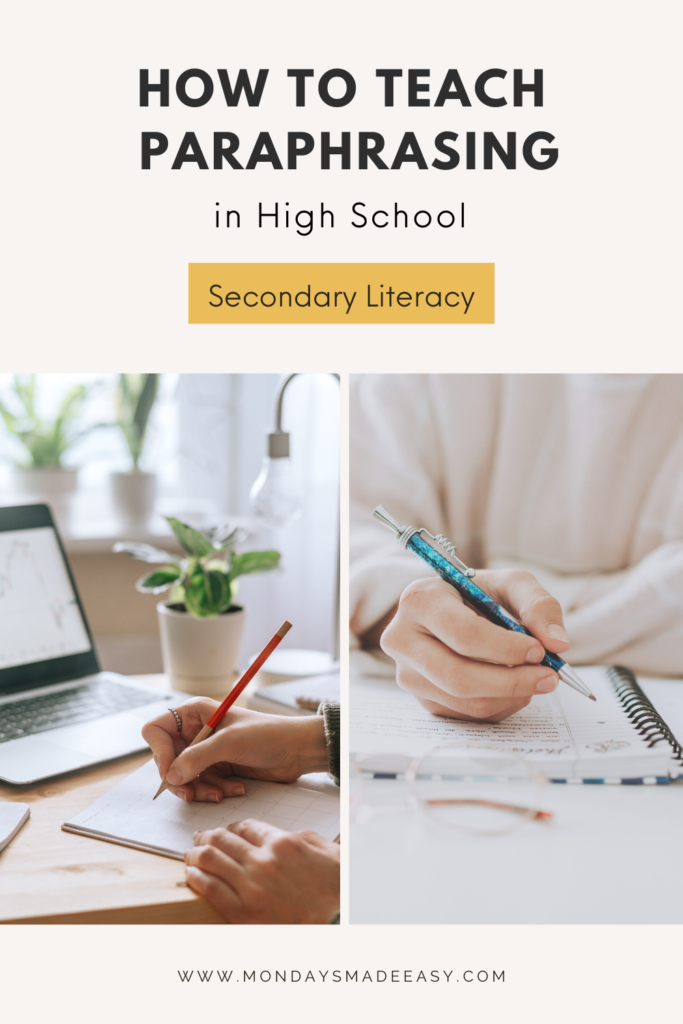
What is the Goal of Paraphrasing?
Put simply, the goal of paraphrasing is to use the student’s own words to rephrase the words of another source. When students use their own words, they demonstrate that they have interpreted the information, made sense of it, and reiterated it to their audience. Thus, the goal of paraphrasing is also to demonstrate the student’s understanding of the source .
Students can also use paraphrasing as a tool to deepen their own understanding of a text . This is especially useful for English Language Learners reading at a new Lexile level. It can also help students reading antiquated texts, like Shakespeare or Beowulf . Finding meaning within each sentence or phrase can act as a stepping stone to understanding challenging texts as a whole.
Finally, an important goal of paraphrasing is to help students avoid plagiarism . Students can avoid direct plagiarism by rewording their sources and reiterating their understanding. Additionally, they can avoid other forms of plagiarism by properly integrating citations into their writing .
What is the Difference Between Paraphrasing and Summarizing?
Knowing the difference between paraphrasing and summarizing is essential for students writing standardized tests , including the Ontario Secondary School Literacy Test (OSSLT) , the AP Language and Composition Exam, and both the SAT and the ACT.
Summarizing involves highlighting the main points of an entire work or idea. A summary includes some of the supporting details, but not all. The goal of a summary is to capture the “big picture. ” In contrast, paraphrasing involves reiterating isolated details within a work or idea . Paraphrasing restates the specific details within a work. It is not necessary to make a connection between these details and the “big picture” of a text.
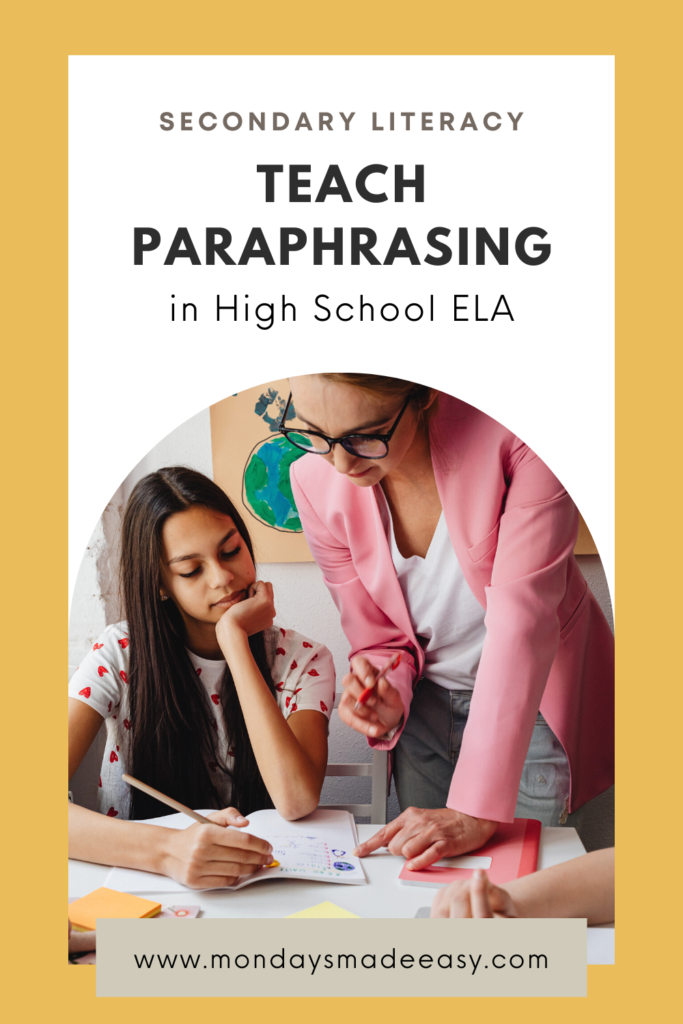
What is the Difference Between Paraphrasing and Annotating?
Paraphrasing and annotating share similarities. For one, both aim to explain a section of a work. Paraphrasing and annotating are also important parts of the close reading process. To differentiate between these two skills, it is best to consider paraphrasing as rewording the text, and annotating as reacting to the text . Deeper analysis, criticism, and opinion are important elements of annotation, but students should avoid including these elements when paraphrasing.
Activities to Teach Paraphrasing to High School Students
Use music to introduce paraphrasing to high school students.
Whether they realize it or not, students are using paraphrasing skills in their everyday life . When sharing information across cultural or generational boundaries, paraphrasing is often necessary. If you’ve ever needed to ask your students to translate modern music or slang, then you’ve essentially asked them to paraphrase! Similarly, if your students have asked you to decode a challenging sentence or paragraph within a text, they’ve also asked you to paraphrase.
A fun way to teach paraphrasing to high school students is to start in their comfort zone. I have had great success with using modern music to teach paraphrasing to older classes. This involves finding song lyrics that rely on slang words or cultural phrases and prompting students to paraphrase each line. Your students will get a kick out of explaining the meaning of these lyrics to you.
Here are some song suggestions for this activity. ( Note that some songs deal with mature themes. )
- “ 3 Nights ” by Dominic Fike
- “ Green Eyes ” by Arlo Parks
- “ Thinkin Bout You ” by Frank Ocean
- “ Sunflower ” by Harry Styles
- “ Don’t Start Now ” by Dua Lipa
With the right group of students, exploring the genre of rap can be a productive and engaging lesson for teaching paraphrasing . Unfortunately, rap music is not written for the classroom – even censored versions deal with mature subject matter. Use your professional judgment to determine whether or not this type of activity would be suitable for your students. The following song lyrics offer cultural dialect and a level of complexity that would be an engaging challenge to paraphrase:
- “ Humble ” by Kendrick Lamar ( censored version )
- “ Savage ” by Megan Thee Stallion ( censored version )
- “ God’s Plan ” by Drake ( censored version )
- “ Oceans ” by Jay Z
- “ The Season / Carry Me ” by Anderson .Paac
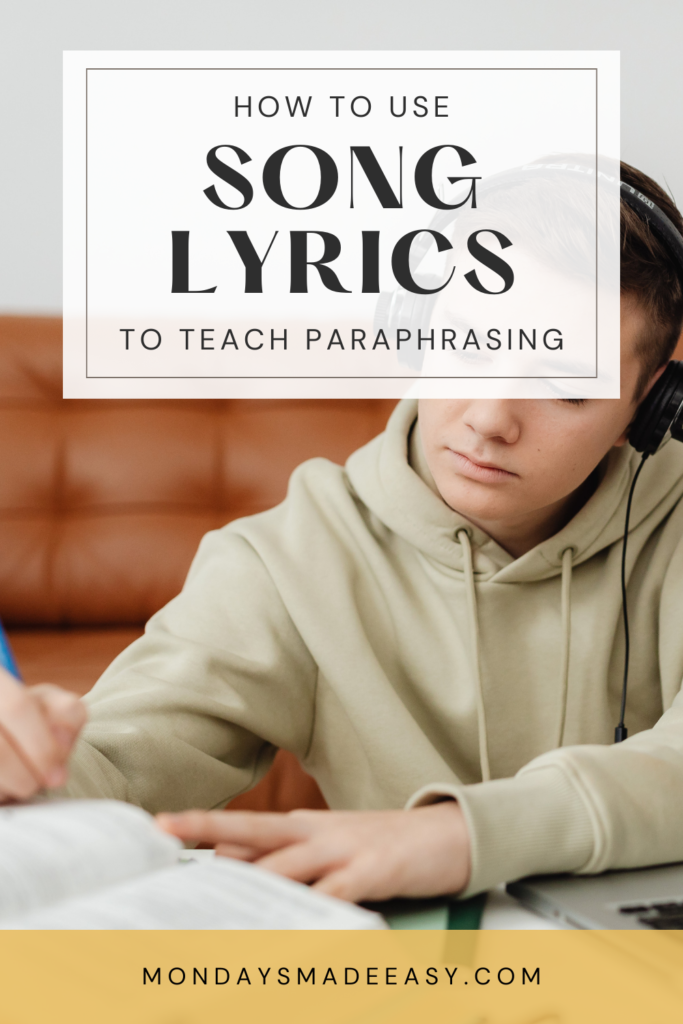
Apply Paraphrasing to More Challenging Texts
Now that students have practiced paraphrasing using high-interest texts , you can challenge them with literature outside of their comfort zone. Simply select an excerpt from a text written in Old English and format it on a worksheet with a blank text box next to the text. Students can paraphrase the text line-by-line to decipher meaning . This activity would pair well with any Shakespeare text in your school curriculum.
Alternatively, you could assign an antiquated text to explore as a class . Some options include The Seafarer , Jonathan Swift’s A Modest Proposal , or the epic poem Beowulf . I find this activity especially effective when I divide a text amongst groups of students and assign them the task of paraphrasing different sections.
Model Paraphrasing During Read-Alouds in High School
Teaching paraphrasing can be as simple as modeling it during a read-aloud period in your classroom. This can involve pausing after reading important parts of the text to reiterate the message. You can also practice paraphrasing aloud after reading complex sentences to offer clarification.
After teaching students about paraphrasing, you can also ask them to paraphrase for you during read-alouds. If you haven’t taught this skill yet, you can simply ask students a simpler prompt, like “In your own words, what is this sentence/paragraph communicating? ”
To differentiate between paraphrasing and annotating , you can ask students to keep their responses separate from their reactions to the text. When they begin to offer too much insight, analysis, or criticism, you can coach them to take a step back and focus simply on the meaning .
To differentiate between paraphrasing and summarizing, you can also prompt students to summarize the text after the read-aloud. If you haven’t taught the skill of summarizing yet, you can simply ask students another simple prompt like “ what is this text about? “
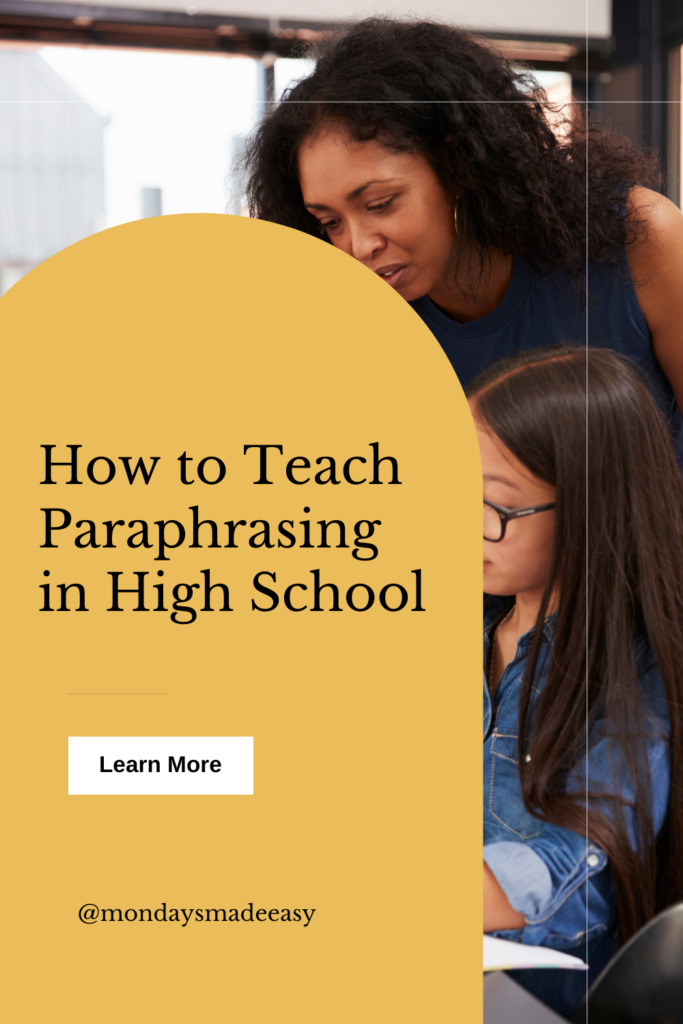
Practice Integrating In-Text Citations to Teach Paraphrasing to High School Students
As mentioned, one of the goals of paraphrasing is to help students avoid plagiarism in their writing. To do so, students must be able to properly integrate in-text citations . These two skills will help students to credit sources and maintain academic integrity.
I teach this skill explicitly to students by practicing in-text citations in class. Mondays Made Easy offers in-text citations practice worksheets to model how to write parenthetical and integrated citations in student writing. These worksheets explore high-interest topics and offer a number of differentiation options , including different Lexile levels and a Tic-Tac-Toe activity to implement student choice.
If you’ve been struggling to teach paraphrasing to high school students , I hope these lesson plans and ideas are able to offer you some engaging solutions. For more activities and advice for the English Language Arts classroom, be sure to follow along on Instagram:

mondaysmadeeasy
Canadian Curriculum Designer and Education Blogger

Reader Interactions
[…] in-text citations indicate where an idea originally came from. The idea could be word-for-word or paraphrased. As their name suggests, in-text citations exist within the text of an essay or paragraph. They […]
[…] You can incorporate classroom playlists into your English Language Arts curriculum in a number of ways. One way would be to simply have students select a song and write about the author’s purpose. Another way would be to assign students a playlist, have them select a song, and then have them paraphrase the music lyrics. […]
latest in US News

NYC Council speaker claims Israel-Gaza signs could...

Michael Cohen was actually whining about 14-year-old prankster...

Cops searching for nut who stabbed woman on college campus in...

NYPD could access shops' surveillance cameras — in real time...

Biden speeds up asylum process for migrants bound for these five...

SC pastor's father calls Mica Miller a 'very, very sick woman,'...

NYS pushes to boot Boeing bigwigs, block executive raises using...

Fani Willis investigated by GOP senators over alleged abuse of...
Pennsylvania school cop accused of molesting student, 14, while chaperoning dance.
- View Author Archive
- Email the Author
- Get author RSS feed
Contact The Author
Thanks for contacting us. We've received your submission.
Thanks for contacting us. We've received your submission.
A twisted Pennsylvania school resource officer was arrested Wednesday for allegedly pressuring a 14-year-old student into a sexual relationship and molesting her during a school dance he was chaperoning.
Costas Nick Alestas, 43, is also accused of sneaking a disturbing up-the-skirt video of an 11-year-old girl as she walked down the hallway at East Hills Middle School in Bethlehem.
Alestas’ alleged abuse came to light last month when the teenager confided in a guidance counselor about the weeks-long relationship, officials said.

Her mother had previously found a trove of dirty text messages between the pair, but Alestas — who was also the school’s co-ed soccer coach — tried avoiding capture by using a second phone number, the Bethlehem Police Department said Wednesday.
“There was deceptive behavior trying to mask who the text messages were from,” Bethlehem Police Chief Michelle Kott said at a press conference.
The teenager quickly gave him up when investigators questioned her, saying he had given her his personal phone number while they were on school grounds.
“The communication with Alestas included conversations about engaging in sexual acts. As the communication between Alestas and the victim continued, the interactions progressed into several encounters involving sexual contact between the two,” the department said in a release.
The perverted encounters allegedly took place both during the school day in his office and after school inside Alestas’s car, police said.

One horrifying incident even occurred “during a school dance while Alestas was on duty and in police uniform.”
That same day, the disgraced school cop also allegedly filmed the video of the second, 11-year-old victim, which was recovered when investigators combed through his phone.
An analysis of Alestas’ phone showed about 4,980 messages exchanged with the 14-year-old, and 49 phone calls, since March 26, according to a police affidavit obtained by Lehigh Valley News.
The arrest came as a shock to the Bethlehem Police Department, who said Alestas was a respected six-year veteran of the department.

“There was no indication that this was going on or that this individual had engaged in any of this behavior. He was well-liked at the school. He had received awards of merit and the past. So this comes as an absolute shock and surprise,” Bethlehem Police Chief Michelle Kott said.
Alestas was immediately placed on administrative leave and has been charged with several felony offenses, including statutory sexual assault, institutional sexual assault and invasion of privacy.
Court records show Alestas was unable to post bail and remains in the county jail.
Alestas became the second school resource officer in Northampton County to be arrested and charged with allegedly carrying out an inappropriate relationship with a student in the last few weeks.
Ex-Easton Area High School officer John Smoke was busted last month after he allegedly “sent explicit photos to an underage student.”
“We need to start talking about whether there’s prophylactic measures. We can take as far as policy and procedures that can lessen opportunities for this kind of behavior,” Northampton County District Attorney Stephen Baratta said Wednesday.
Share this article:

Advertisement
- Election 2024
- Entertainment
- Newsletters
- Photography
- Personal Finance
- AP Investigations
- AP Buyline Personal Finance
- AP Buyline Shopping
- Press Releases
- Israel-Hamas War
- Russia-Ukraine War
- Global elections
- Asia Pacific
- Latin America
- Middle East
- Election Results
- Delegate Tracker
- AP & Elections
- Auto Racing
- 2024 Paris Olympic Games
- Movie reviews
- Book reviews
- Personal finance
- Financial Markets
- Business Highlights
- Financial wellness
- Artificial Intelligence
- Social Media
High school students, frustrated by lack of climate education, press for change
Youth activists pushing for more climate education in Minnesota schools say working with peers to draft legislation gives them hope for a future under threat. (AP Video: Mark Vancleave)
B Rosas, left, Lucia Everist, center, and Libby Kramer, of Climate Generation, speak to the Minnesota Youth Council, Tuesday, Feb. 27, 2024, in St. Paul, Minn. The advocates called on the council, a liaison between young people and state lawmakers, to support a bill requiring schools to teach more about climate change. (AP Photo/Abbie Parr)
- Copy Link copied
Libby Kramer, left, Lucia Everist, center, and B Rosas, of Climate Generation, speak to the Minnesota Youth Council, Tuesday, Feb. 27, 2024, in St. Paul, Minn. The advocates called on the council, a liaison between young people and state lawmakers, to support a bill requiring schools to teach more about climate change. (AP Photo/Abbie Parr)
Lucia Everist, of Climate Generation, center, speaks to the Minnesota Youth Council, Tuesday, Feb. 27, 2024, in St. Paul, Minn. The advocates called on the council, a liaison between young people and state lawmakers, to support a bill requiring schools to teach more about climate change. (AP Photo/Abbie Parr)
FILE - Water floods a damaged trailer park in Fort Myers, Fla., Oct. 1, 2022, after Hurricane Ian passed by the area. (AP Photo/Steve Helber, File)
Minnesota Sen. Nicole Mitchell, left, sits with members of Climate Generation, from second left, B Rosas, Lucia Everist, Libby Kramer and Minnesota Rep. Larry Kraft, right, as they speak the Minnesota Youth Council, Tuesday, Feb. 27, 2024, in St. Paul, Minn. The advocates called on the council, a liaison between young people and state lawmakers, to support a bill requiring schools to teach more about climate change. (AP Photo/Abbie Parr)
Libby Kramer, of Climate Generation, right, speaks to the Minnesota Youth Council, Tuesday, Feb. 27, 2024, in St. Paul, Minn. The advocates called on the council, a liaison between young people and state lawmakers, to support a bill requiring schools to teach more about climate change. (AP Photo/Abbie Parr)
B Rosas, back left, Lucia Everist, back center, and Libby Kramer, back right, of Climate Generation, speak to the Minnesota Youth Council, Tuesday, Feb. 27, 2024, in St. Paul, Minn. The advocates called on the council, a liaison between young people and state lawmakers, to support a bill requiring schools to teach more about climate change. (AP Photo/Abbie Parr)
ST. PAUL, Minn. (AP) — Several dozen young people wearing light blue T-shirts imprinted with #teachclimate filled a hearing room in the Minnesota Capitol in St. Paul in late February. It was a cold and windy day, in contrast to the state’s nearly snowless, warm winter.
The high school and college students and other advocates, part of group Climate Generation, called on the Minnesota Youth Council, a liaison between young people and state lawmakers, to support a bill requiring schools to teach more about climate change .
Ethan Vue, who grew up with droughts and extreme temperatures in California, now lives in Minnesota and is a high school senior pushing for the bill.
“I just remember seeing my classmates always sweating, and they’d even drench themselves in water from the water fountains,” Vue said in a phone interview, noting climate change is making heat waves longer and hotter, but they didn’t learn about that in school.
“The topic is brushed on. If anything, we just learn about, there’s global warming, the planet’s warming up.”
Libby Kramer, left, Lucia Everist, center, and B Rosas, of Climate Generation, speak to the Minnesota Youth Council, Tuesday, Feb. 27, 2024, in St. Paul, Minn. (AP Photo/Abbie Parr)
In places that teach to standards formulated by the National Science Teachers Association, state governments and other organizations, many kids learn about air quality, ecosystems, biodiversity and land and water in Earth and environmental science classes.
But students and advocates say that is insufficient. They are demanding districts, boards and state lawmakers require more teaching about the planet’s warming and would like it woven into more subjects.
Some states and school districts have moved in the opposite direction. In Texas , the board of education turned down books with climate information. In Florida, school materials deny climate change .
“Someone could theoretically go through middle school and high school without really ever acknowledging the climate crisis,” said Jacob Friedman, a high school senior in Florida who hasn’t learned about climate except for in elective classes. “Or even acknowledging that there is an issue of global warming.”
That’s bizarre to Friedman, who experienced firsthand when Hurricane Ian closed nearby schools and submerged homes in 2022.
A study conducted after the storm found that climate change added at least 10% more rain to Hurricane Ian. Experts also say hurricanes are intensifying faster because of the extra greenhouse gases in the atmosphere that are collecting heat and warming the oceans.
“What an unfair reality to have a young person graduate from high school,” said Leah Qusba, executive director of nonprofit Action for the Climate Emergency, “without knowing about the biggest existential threat that they’re going to face in their lifetime.”
Some places are adding more instruction on the subject. In 2020, New Jersey required teaching climate change at all grade levels. Connecticut followed, then California. More than two dozen new measures across 10 states were introduced last year, according to the National Center for Science Education.
Libby Kramer, of Climate Generation, right, speaks to the Minnesota Youth Council, Tuesday, Feb. 27, 2024, in St. Paul, Minn. (AP Photo/Abbie Parr)
Where some proposals require teaching the basic science and human causes of climate change , the Minnesota bill goes further, requiring state officials to guide schools on teaching climate justice, including the idea that the changes hit disadvantaged communities harder .
Some legislators say they’ve heard from school administrators and teachers who say that goes too far.
“What was said to me is: ‘Why are we pushing a political perspective, a political agenda?’” Minnesota Rep. Ben Bakeberg, a Republican, said during a House Education Policy Committee hearing in March 2023. “That’s a reality.”
The bill didn’t advance in the 2023 session. Now it hasn’t this year either. Supporters say they will try again next year.
Aware of such opposition, some students interested in climate opt to campaign at their schools rather than through the legislative process.
Three years ago, floods destroyed Ariela Lara’s mom’s village in Oaxaca, Mexico, while they were visiting. Then Lara came home to California and was hit by smoke-filled skies caused by wildfires that pushed thousands to evacuate or be stuck inside for weeks.
Yet despite what she was seeing, Lara felt in school she was only taught about recycling and carbon footprints, a measure of a person’s personal greenhouse gas emissions.
So she went to the board of education.
“I had to really think about how I could go to the people in power to really rewrite the curriculum we were learning,” Lara said. “It would get so tiresome because for me, I was the one that was really trying to enforce it.”
By the time her school offered Advanced Placement Environmental Science, Lara was too senior to enroll in it. AP Enviro does cover climate change , according to the College Board, but it’s also more broad.
B Rosas, back left, Lucia Everist, back center, and Libby Kramer, back right, of Climate Generation, speak to the Minnesota Youth Council, Tuesday, Feb. 27, 2024, in St. Paul, Minn. (AP Photo/Abbie Parr)
When targeted efforts don’t work, some students feel they’re on their own.
For high school junior Siyeon Joo, climate education seems like a no-brainer where she lives in Lafayette, Louisiana, which was hit hard by Hurricane Katrina in 2005 and has been affected by several other intense storms and heat waves.
But Joo wasn’t exposed to climate change at her public middle school and an educator there once told her it wasn’t real.
“I remember sitting in that classroom,” the now-16-year-old said, “being really angry that that was the system that was being forced upon me at the time.”
It took enrolling in a private school for Joo to learn about these topics. Many students don’t have that option.
Experts say climate material could be worked into lessons without burdening schools or putting the onus on students. But much like with legislation, that will take time students say they don’t have.
“I was part of these communities that were really just affirming how much is at stake if we don’t take action,” said Lara, the student in California, recalling how important to her it would have been to receive education about her experiences. “You should be able to go to school and learn about the gravity which the climate crisis is at.”
Alexa St. John reported from Detroit and Doug Glass reported from St. Paul, Minn.
Alexa St. John is an Associated Press climate solutions reporter. Follow her on X, formerly Twitter, @alexa_stjohn . Reach her at [email protected] .
The Associated Press’ climate and environmental coverage receives financial support from multiple private foundations. AP is solely responsible for all content. Find AP’s standards for working with philanthropies, a list of supporters and funded coverage areas at AP.org .

How a middle school is successfully keeping students off their phones during class

Amna Nawaz Amna Nawaz

Courtney Norris Courtney Norris
Leave your feedback
- Copy URL https://www.pbs.org/newshour/show/how-a-middle-school-is-successfully-keeping-students-off-their-phones-during-class
As schools grapple with how to keep students off their cell phones, one Connecticut school took a blunt approach. In Manchester, Illing Middle School requires students to lock phones in a pouch until the end of the day. It comes as lawmakers in at least half a dozen states are pushing their schools to curb phone use. Amna Nawaz discussed more with Illing assistant principal Raymond Dolphin.
Read the Full Transcript
Notice: Transcripts are machine and human generated and lightly edited for accuracy. They may contain errors.
Amna Nawaz:
As schools nationwide grapple with how to keep students off their cell phones, one Connecticut school took a blunt approach.
In Manchester, Illing Middle School banned all cell phone use, requiring students to lock phones in a pouch until the end of the school day. The backlash from students and some parents was swift. Illing even offered to have administrators unlock a student's phone if needed.
But, within weeks, school staff said that wasn't even necessary. This comes as lawmakers in at least a half-a-dozen states are pushing their schools to curb cell phone use.
Illing Middle School's assistant principal, Raymond Dolphin, joins me now.
Welcome, and thanks for joining us.
So tell us a little bit about what the problem was that you were trying to fix in the first place. Why the ban?
Raymond Dolphin, Assistant Principal, Illing Middle School:
The number one problem was that the cell phones were interfering with the student — the learning of our students in the classrooms.
As we administrators were visiting classrooms, as well as listening to other teachers, we would regularly hear or witness ourselves, when the teacher was providing instruction, students were being distracted on their cell phones.
So you spearheaded this move. And we should note this wasn't about limiting use during the school day or giving teachers the power to take phones away if there are problems. You basically said no phones all day, that's it, lock it away.
Why that approach?
Raymond Dolphin:
We, as an administrative team, led by our principal, Ms. Idelisa Torres, what we found is that, for even adults, it's really difficult for them to manage their cell phone use.
And, for students, it's even that much more challenging, just, as age-appropriate, for them to struggle even more so. To just tell them it's effective to use your phone at this time and not that time, students weren't able to handle that. Any time their phone would vibrate or an alert would come off or just throughout the day because they were curious about a friend's response, they would be — they would find themselves looking on their cell phone.
What kind of reaction did you get from students and from parents?
So, initially, of course, our students, they had major resistance. They thought it was — they were a lot — a lot of them were very, very fearful.
What does it seem — what does it look like for me not to have access to my phone, when this device is something that, for some students, they would sleep with? And so it was a lot of fear there, a lot of frustration. But they soon adapted to it and responded very well.
For the majority of our parents, we have a philosophy out here in Manchester Public School where we don't just do things to our community, we do them with them. And so we have already sent out surveys and asked a lot of parents if they were on board and also thought that there was something that we needed to do. And they signed up on it as well overwhelmingly.
And so that just left a small minority of parents that we had to kind of coach through the process of resistance.
There is an expectation, as I'm sure you have seen in your school community too, among some parents that they want to be able to reach their kids during the school day. They want their kids to be able to reach them in an emergency or for support or a similar situation.
Did you see any of that? And how do you respond to those concerns?
Those concerns are legitimate, but we already have solutions already built in.
Every single classroom that we have in this building has at least one phone in it, and most of them have two phones. So, if something comes up where a student actually needs to reach their parent, they can just simply ask for permission, and they have the opportunity to call their parent.
If the parent wants to reach their student, they can call the main office and we can get messages to them. So you have access to your students. And the only change is that that immediate, like this-second reaction to send a text or send multiple texts is no longer there.
So, families do have to be a little bit more planned, but that opportunity still exists.
Can I ask, just out of curiosity, the phones in the classrooms, those are probably landlines. Is this the first time some of your kids have had to use a landline?
Yes. It's funny that you brought that up, because we adults were remarking about that at the beginning of the process, just at how many students were asking us, how do I use this phone?
And so we were floored at that.
But there was a lot of students who had that question, yes.
As you know, when you take a look at the broader picture, the statistics are clear. The National Center for Education Statistics found, in 2020, there were already cell phone bans in place in 76 percent of U.S. schools, but then another survey found some 97 percent of students who have cell phones are still using them during the school day for about 45 minutes or so.
So what is your advice for schools who want to try to enforce bans, take cell phones out of the classrooms, but don't know how to do that?
So that statistic doesn't surprise me. That discrepancy exists. We even had something similar. My advice to everyone is to not treat the Yondr pouches as the magic solution. It's one tool that is a major part of your overall strategy to solve this problem.
You need to elicit support from parents. You need to ensure that, like your school community, your teacher support staff and administration are all on the same page, and consistency, consistency, consistency is the most important thing.
All right, that is Illing Middle School's assistant principal, Raymond Dolphin, from Manchester, Connecticut, joining us today.
Assistant Principal Dolphin, thank you. Appreciate your time.
Thank you very much.
Listen to this Segment

Watch the Full Episode
Amna Nawaz serves as co-anchor of PBS NewsHour.
Courtney Norris is the deputy senior producer of national affairs for the NewsHour. She can be reached at [email protected] or on Twitter @courtneyknorris
Support Provided By: Learn more
More Ways to Watch
- PBS iPhone App
- PBS iPad App
Educate your inbox
Subscribe to Here’s the Deal, our politics newsletter for analysis you won’t find anywhere else.
Thank you. Please check your inbox to confirm.
ASU program celebrates 40 years of paving the way for first-generation college students
When Stephany Janette Hernandez was in eighth grade, she and her family embarked on a journey that would change the course of her educational future.
Five years later, on Monday, Stephany and her twin brother, Michael Damian, were celebrated among hundreds of other students and their families who, thanks to an Arizona State University program, were supported from an early age so that they may receive a college education.
The Hispanic Mothers and Daughters Program is an initiative by ASU Access that provides college readiness resources and support to Arizona families that help students in grades 8-12 prepare and be admitted into college through family engagement.
On the 40th anniversary of the program, 252 high school students walked through a room to receive their certificates accompanied by their parents, who were equally recognized for their time and commitment.
The purpose of this program is to serve the family, regardless of culture or sociocultural level, according to the deputy director of the program, Ingrid Estrada. “What the leadership of this program seeks is to be able to increase the number of Hispanic students. Our goal is to increase the number of seniors who come to ASU and not just ASU, any university,” Estrada told The Arizona Republic. “The long-term vision is to continue helping and welcoming more families.”
The Hernandez family was among those recognized.
40 years of paving the way for Latinas, students of color
Established in 1984, the program has supported nearly 2,500 families.
Starting in seventh grade, ASU recruiters begin connecting with families across various school districts to identify those interested in receiving resources and training.
The program features online and in-person courses, with visits to the ASU Tempe campus every six months over five years, and all courses are offered in English and Spanish. Additionally, high schoolers attend workshops focused on college admissions and financial aid to prepare them during the application process.
Stephany started with the Hispanic Mothers and Daughters Program in middle school. She and her mother, Armida Hernandez, have attended each and every session since 2019.
“At first it was quite intimidating because university felt so far away. We joined the program right before the pandemic shut everything down, but it was still like four or five years away, and I was like, 'Why do I need to prepare now?'” Stephanie told La Voz Arizona. Having finished the program, she now understands just how impactful the sessions are.
Stephany and Michael will graduate high school in May to continue their higher education at the end of the summer.
Upon graduating from Franklin Police and Fire Department High School in Phoenix, where she had a perfect attendance record all four years, Stephany will participate in an internship with the Arizona Department of Public Safety as part of the criminal records team during the summer. Upon completion, she is enrolled to begin her bachelor's degree at ASU's West Valley Campus, majoring in criminology and criminal justice.
“HMDP showed us the importance of several things that concern admissions”, Stephany said during her speech at Monday's ceremony, representing the program's graduates. “Without these things, we probably wouldn't be here today or be able to graduate.”
Before the program, Stephany's parents were unfamiliar with the U.S. educational system. Having been born and raised in Colima, Mexico, her mother did not understand what accessing higher education entailed. Her participation in the program represented a “before and after” for her and her entire family.
“The program has helped us a lot to get us on track to go straight to university,” Hernandez said. “It has been a great experience for us because now we know the requirements, we know a little more about the system, and in fact, we have been able to help other students."
Hernandez works directly with her community through her Estrella Super Moms Facebook account and for 12 years she has provided information and resources to families who, having immigrated to the U.S. from other countries, want to know how to navigate the education system.
A new focus for the Hispanic Mothers and Daughters Program
Although the Hispanic Mothers and Daughters Program was originally designed to serve Latina mothers and their daughters exclusively, as well as support first-generation students, today any interested student and family is considered, regardless of race, ethnicity or gender, according to Estrada.
More than 50% of freshmen enrolled at ASU in 2017 came from underrepresented communities. The pandemic changed the focus of the Hispanic Mothers and Daughters Program and, since then, barriers have been reduced and access has been expanded for all types of families to enter the program, according to Estrada, who also highlighted the importance of parent participation, who are often the ones encouraging their children.
Of the more than 200 high school students who received their certificates on Monday, 121 will begin their college careers at ASU this fall. Also recognized during the ceremony were 18 ASU bachelor's graduates who were program participants in the previous decade.
Chandler Municipal Court Presiding Magistrate Alicia Skupin, who participated in the Hispanic Mothers and Daughters Program more than 35 years ago, offered words of motivation to students and families on Monday who, like her, have experienced challenges and obstacles on her path toward higher education.
“My family didn't know engineers, doctors, accountants, lawyers, scientists or computer programmers. My parents knew college was important, but they didn't know the path or how to get me there except to do well in school. That's where HMPD came in, during my eighth grade. Turn an obstacle into an opportunity,” Skupin, whose mother is originally from Sonora, Mexico, told the audience. “For parents in the room, there are so many examples of how we can change what we see as an obstacle into an opportunity. So many lessons for our children to learn.”
Reach La Voz reporter Silvia Solis at [email protected] .
College Scholarships for Lesser-Known Sports
Students can compete for money by excelling in less-common sports like archery, curling, esports, pickleball and surfing.
Scholarships for Lesser-Known Sports
Some sports – such as football , soccer, basketball and baseball – tend to garner significant attention and college funding . But scholarship money is often still available for less-common athletic abilities.

Getty Images
At the institutional level, there are financial restrictions for non- NCAA sports . However, students can search for scholarships from third-party sources, such as nonprofits or local organizations.
"There are some colleges that will have some scholarships for non-NCAA sports that are at the club level that maybe an alum has donated money to," says Kelly Herrington, director of college counseling and student services at UPrep Seattle, a private school for grades 6-12 in Washington.
At NCAA schools, he adds, "you have regulations around who you can give scholarships to. You can only provide scholarships at the Division I level. The athletic scholarships out there are going to have to come at the club level. They can't be anything where the students are competing in the intercollegiate athletic association."
Here are examples of outside or college -associated scholarships for unique sports that may be offered as a club or intramural activity on campuses.
Examples of Scholarships for Less-Common Sports
Archery enthusiasts can compete for both medals and college scholarships at the Junior Olympic Archery Development National Target Championships. These scholarships are reserved for top finishers.
However, students don't need to be the star player to win a sports scholarship, experts say.
"It's really about showing your interest in the sport" and your leadership abilities, says Christopher Gray, founder and CEO of Scholly, a scholarship app recently acquired by Sallie Mae.
For instance, members of the Minnesota State Archery Association who are graduating high school students with a demonstrated interest in archery may qualify for a $500 college scholarship.
While there are national curling scholarships, students can also look to see if a local curling club provides any college funding.
The Schenectady Curling Club in New York offers a Charlie Brown Memorial Scholarship – established in the 2023-2024 season – that provides a one-time scholarship of $500. There's no grade or transcript requirement, but applicants must be a high school senior and current or past member of the club's Juniors program. Funding can be used for any postsecondary education-related expenses.
Video game lovers can take their passion to a competitive level in college. Many institutions have started to build their own gaming arenas in an effort to recruit students for their esports teams.
Every year, for example, more than 15 esports players at Harrisburg University of Science and Technology in Pennsylvania receive academic scholarships that cover the full cost of tuition, as well as housing support.
"Esports scholarships are everywhere," Herrington says. "My message to middle school families or families just starting high school is: Who knows, that niche thing that you are doing may actually become more mainstream and there may be more scholarships in it."
Pickleball has been growing in popularity across the U.S., including on college campuses.
At Utah Tech University , students can apply for the Pickleball Club Scholarship, which covers up to six credit hours of tuition costs. Selected candidates become part of the team as either a player or officer. Applicants must have at least a 3.0 GPA and commit to volunteering a minimum of 20 hours per semester for club-related projects.
Compared to other sports on this list, surfing is more geographically limited. However, there are still scholarships out there for surfers.
The International Surfing Association distributes up to $20,000 in award money each year, ranging between $100 and $1,000 per recipient. The amount is determined case by case.
To qualify, students must be 18 years or younger, demonstrate financial need, be outstanding role models in their community and be recommended by their country's National Surfing Federation. Funding can be used for tuition, books, transportation, training, coaching, contest fees, surfboards and other equipment.
How to Stand Out on Scholarship Applications
In the application, it's important for students to discuss why they became interested in that particular sport. Additionally, they can mention "how they've grown as a result of their participation, how they'll contribute to their collegiate community in that particular sport and how they've applied the lessons from that sport to other areas of their life," Herrington says.
Essays should be used to tell a story rather than paraphrase a resume, Gray says. He recommends keeping responses brief – around 500 words – if there is no word count.
However, students shouldn't spend all their time applying for these scholarships.
"I always tell students to focus most of your attention on doing well in school and your grades and taking a strong curriculum," Herrington says. "The vast majority of money that's given to students for outside scholarships is going to come as a result of your academic work."
But, he adds, "there is a really impressive narrative when you stick with something that maybe not (many) other people are involved in because you are seen as doing it out of genuine passion and interest, not because of public glory. Colleges love that. ... So even if they don't get a scholarship, they are still going to get rewarded in the college process because of that interest that they have."
Trying to fund your education? Get tips and more in the U.S. News Paying for College center.
Facts About Merit Aid Scholarships

Tags: paying for college , paying for community college , colleges , students , education , scholarships , sports
College Admissions: Get a Step Ahead!
Sign up to receive the latest updates from U.S. News & World Report and our trusted partners and sponsors. By clicking submit, you are agreeing to our Terms and Conditions & Privacy Policy .
Ask an Alum: Making the Most Out of College
Paying for College
College Financial Aid 101

College Scholarships

College Loan Center

College Savings Center

529 College Savings Plans

Get updates from U.S. News including newsletters, rankings announcements, new features and special offers.
Sign in to manage your newsletters »
Sign up to receive the latest updates from U.S News & World Report and our trusted partners and sponsors. By clicking submit, you are agreeing to our Terms and Conditions & Privacy Policy .
You May Also Like
Fafsa delays and decision day: survey.
Erika Giovanetti May 1, 2024

FAFSA Delays Alarm Families, Colleges
Sarah Wood March 25, 2024

Help Your Teen With the College Decision
Anayat Durrani March 25, 2024

20 Lower-Cost Online Private Colleges
Sarah Wood March 21, 2024

How to Avoid Scholarship Scams
Cole Claybourn March 15, 2024

What You Can Buy With a 529 Plan
Emma Kerr and Sarah Wood March 1, 2024

What Is the Student Aid Index?
Sarah Wood Feb. 9, 2024

Affordable Out-of-State Online Colleges
Sarah Wood Feb. 7, 2024

The Cost of an Online Bachelor's Degree
Emma Kerr and Cole Claybourn Feb. 7, 2024

How to Use Scholarship Money
Rebecca Safier and Cole Claybourn Feb. 1, 2024

FAFSA Deadlines You Should Know
Sarah Wood Jan. 31, 2024

What's New on the 2024-2025 FAFSA

College Financial Planning for Parents
Cole Claybourn Jan. 29, 2024

How to Find Local Scholarships
Emma Kerr and Sarah Wood Jan. 22, 2024

Help for Completing the New FAFSA
Diona Brown Jan. 11, 2024

Aid Options for International Students
Sarah Wood Dec. 19, 2023

10 Sites to find Scholarships
Cole Claybourn Dec. 6, 2023

A Guide to Completing the FAFSA
Emma Kerr and Sarah Wood Nov. 30, 2023

Are Private Student Loans Worth It?
Erika Giovanetti Nov. 29, 2023

Colleges With Cheap Out-of-State Tuition
Cole Claybourn and Travis Mitchell Nov. 21, 2023

A new law makes Ohio schools limit student phone use. Are central Ohio districts ready?
Gov. Mike DeWine signed a bill Wednesday requiring districts to make policies reducing student phone use. Are central Ohio districts prepared?
The new law, which passed the Ohio House last week, requires K-12 school districts to create a policy to reduce cellphone distractions and limit cellphone use as much as possible during school hours, The Dispatch previously reported. The Ohio Department of Education and Workforce would create a model policy for schools that don't choose to create their own.
DeWine and Lt. Gov. Jon Husted have made student cellphone and social media use a priority. On Wednesday, DeWine said at Karrer Middle School in the Dublin City Schools district that the bill he was signing ensures every school has a discussion about cellphone distractions in schools.“Cellphones in classrooms pose a significant challenge to learning, undermines instruction and exposes our kids to potential harmful content,” DeWine said.
John Marschhausen, Dublin City Schools superintendent, thanked the governor and lieutenant governor Wednesday for their work on cellphones, saying that they had taken action just a few months after holding a town hall with educators at Dublin City Schools in March.
"We know that cellphones in our schools are a distraction," Marschhausen said. "We know that cellphones in our school and the proliferation of social media have a negative impact on the students that we serve.”
Central Ohio districts feel OK under new state law
Some of the region's largest districts say they are confident that their policies address student cellphone use during the school day .
In the South-Western City School District, the fifth largest in the state, the board of education was actively working on updating their cellphone policy before the state gained an interest on the topic, according to spokesperson Evan Debo. On Monday, the board heard a first reading of a proposed policy that reduces cellphone use and limits use during school hours to when permission is given by a teacher or administrator .
"While the district has had existing policy that restricted student cellphone use, the amended policy brought forward on Monday enhances expectations and understanding regarding their limited use in schools," Debo said.
The board plans to go through a second public reading on the initiative vote June 10 before the new policy is fully adopted.
Olentangy Local Schools, the state's fourth-largest district, said that it does not believe legislation will have an impact on its district. While phones are not banned on school property, the policy for use is strict, according to spokesperson Amanda Beeman.
In elementary school, for example, cellphones can't be used on the playground and use is at the discretion of building administrators. At the high school and middle school levels, there may be more leniency at lunch or during downtime. Outside of the specific places and times when a phone is allowed to be used, it must be away or there may be discipline.
More: Ohio school cellphone ban? Here's how Columbus area districts handle student phones.
Columbus City Schools, the state's largest with over 45,000 students, told The Dispatch that the district "has policy in place that speaks clearly to personal communication devices." Under CCS policy, cellphones should be stowed during the instruction day, unless they are being used as part of the instruction.
Westerville City Schools said it contracts with a third-party group, Neola, to ensure all policies are compliant with state law. The district will review the new law, compare it to its policy and provide necessary updates, spokesperson Greg Viebranz said.
"The bottom line is that we're going to make sure we're compliant, whether that's possible through current policy or if we need to make necessary updates," Viebranz said.
Experts: Emerging science shows student phone use bad for learning
Many existing studies give evidence that allowing phones in the classroom negatively impacts test scores and long-term learning retention, according to Harvard University . However, the research also notes that many bans are repealed due to student and parent unpopularity, and in urban districts, often because cell service remains the only method of connectivity for some students.
A 2021 U.S. Department of Education study of existing research found that while some studies have shown that cellphone use in a classroom can help prepare students for work and inspire innovation, others demonstrate a detrimental effect of being distracting from education, as well as a rise in problems like cheating and teen sexting.
Heather Hill, a professor in teacher learning at The Harvard Graduate School of Education and expert on education policy, said the literature that exists on cellphone usage in classrooms shows it has a negative effect on learning outcomes.
She said it is probably a good move by the state to increase student engagement and give teachers one less thing to manage while teaching.
“This is also backed up by what we hear from teachers, which is, when kids have their cell phones or they have their computers enabled to do texting, they’re just not fully engaged in class,” Hill said. “Classroom engagement is probably the number one predictor of actual learning.”
USA Today Ohio Bureau reporter Erin Glynn contributed to this report.
@Colebehr_report
Dwyer Awards 2024: Seven teachers honored as best of the best. What to know about them
The annual celebration of great educators honored teachers from the glades, west palm beach, boca raton, greenacres, palm springs and wellington..

WEST PALM BEACH — The 2024 Dwyer Awards for Excellence in Education were presented to seven teachers Tuesday night at the Kravis Center to honor their spirit and dedication to Palm Beach County's students.
The best of the best represent Liberty Park Elementary, Seminole Trails Elementary, Pioneer Park Elementary, Palm Springs Middle, Bak Middle School of the Arts, Emerald Cove Middle and Olympic Heights High.
Among this year's winners is an educator who re-established a school step team and won state recognition for its performances, a school counselor who helped fund a student's safety patrol trip when her family needed a hand and a teacher who moved from Jamaica as a child who focuses on the ability of every child to learn.
Superintendent Mike Burke addressed the group from the Kravis Center stage, congratulating the school district's slate of winners for "making success unavoidable for students."
"The teacher is the sole most important ingredient for the success of the kids," Burke said. "Our finalists tonight are the cream of the crop and part of an elite group of educators.
Speaking directly to the finalists, he said "you all and your colleagues are the reason we're able to provide the highest quality of education in Palm Beach."
What are the Dwyer Awards for Excellence in Education?
The Dwyer Awards were launched in 1984 to honor outstanding educators from Palm Beach County public and private schools. All of the 2024 winners teach at district-run public schools.
Supported by the Economic Council of Palm Beach County, the annual awards program highlights exemplary teaching in the community and supports educators with financial awards for their excellence in the classroom.
Award recipients receive $3,500 and a personalized crystal award. Finalists receive $500 and a personalized certificate.
Bill Dwyer, the son of William T. Dwyer, opened the ceremony by recognizing all of the finalists and educators in the audience. Dwyer said his father was known to profess that "better schools make a better county."
Dwyer added that his father would be amazed by the "caliber of the educators" present in the room and "humbled to have his name associated with this event and all it stands for."
Winners of 2024 Dwyer awards
Here are this year's winners and the categories each educator won:
- Early Elementary Education: Nathalee English , Liberty Park Elementary
- Elementary Education: Lois Gray, Seminole Trails Elementary
- Middle School Education: Shakendra Moorer, Bak Middle School of the Arts
- Senior High Education: Kimberly Coyle, Olympic Heights High
- STEM Education: Claudia Chavarria, Pioneer Park Elementary
- Exceptional Education: Jessica Maharrey, Palm Springs Middle School
- Student Support and Advancement: Mary Jannell Leatherman, Emerald Cove Middle School
Early Elementary Education: Nathalee English
English spends her days with energetic 3- and 4-year-old students at Liberty Park Elementary in Greenacres. Several of her students have communication issues or emotional regulation challenges that she must get creative to address.
Recently, her classes put on an "alphabet parade" with the school's kindergarten students and a "storybook character dress-up parade," where she and other teachers encouraged their students to create outfits that reflected their favorite fictional characters.
"My students did an incredible job, and students from first grade to fifth grade cheered us on. This did so much to improve the confidence of our early learners," English said.
Outside the classroom, English maintains the school's garden and creates a place of tranquility even as the world continues to change rapidly around her. Entering her 10th year of teaching, English said she's excited to meet the next generation of leaders.
"I believe that every child has the opportunity to bring something unique and special to the world, and my role as a teacher is to give them the tools to cultivate their gardens of knowledge," she said.
Elementary Education: Lois Gray
Gray realized from a young age that education was the key ingredient in creating a successful life.
When she was just 8 years old, she came to the United States with her parents and five siblings from Jamaica. Her childhood was full of opportunities to appreciate education as she watcher her parents take night classes to get ahead in the American job market.
Now a fourth-grade teacher at Seminole Trails Elementary in West Palm Beach, Gray shares the philosophy that has guided her past 25 years in education: All children can learn. They are our future.
Gray hopes to pass on her passion for education to the next generations through her "Future Teachers of Tomorrow" club, which students join to learn about how to become an educator. Her club has visited Florida Atlantic and Lynn universities to help the third-, fourth- and fifth-grade students become familiar with college campuses and what it's like to be a professor.
But the club goes beyond that. Gray's group has created holiday greeting cards for the elderly, collected necessities to send to Floridians impacted by Hurricane Ian and collected food for the Palm Beach County Food Bank.
Middle School Education: Shakendra Moorer
Moorer knows the power of a performance.
After all, she is responsible for building Bak Middle School's radio broadcast program and for revitalizing its step team. Moorer took the step team from a handful of students struggling to perform together to a 30-member group that has been honored as the top-scoring middle school team in Florida.
Within the team, she created a "big sister" mentoring program that has helped girls involved feel more connected to and responsible for each other.
As a 12-year educator and the media and communications teacher at Bak, Moorer cherishes the moments where her students have found passion for journalism and succeeded. This year, the school's radio broadcast program won several awards from the Florida Scholastic Press Association at its state conference in Orlando.
"I make it my mission to learn more about my students daily. I believe it is important to see students as individuals and not just bodies in the classroom," she said. "It is essential that as educators we help students to develop a growth mindset and innovative thinking while understanding their culture and what makes them THEM."
Senior High Education: Kimberly Coyle
Acting, theater and musical theater are all best done together on stage. So the change to virtual teaching was deeply disruptive for drama students and even for Coyle, who had been teaching for 13 years, at the start of the pandemic.
"Theater is about the love of a live community, and virtual learning felt more like a séance; having to call a students’ name over again only to be staring at a video of their ceiling fan. 'Bueller? Buller?' " she said, referencing the 1986 film "Ferris Bueller's Day Off."
But students at Olympic Heights came back better than ever under her leadership.
This year, her students' production of "The Curious Incident of the Dog in the Night-Time" was one of just two plays from across the state chosen to tour and perform with the Florida State Thespian Festival. Nearly 30 students traveled to Tampa to put on the play for 2,000 fellow theater-lovers.
In addition to her work directly with students, Coyle is the producer of Olympic Heights' "Mane Event," a showcase of fine arts students' work that is designed to foster understanding and respect across musical disciplines and art mediums.
STEM Education: Claudia Chavarria
Trying to understand math brings up a lot of emotions for students, especially those in Chavarria's accelerated math programs at Pioneer Park Elementary in Belle Glade.
As an educator of eight years, Chavarria is trained to recognize when first-, fourth- and fifth-grade students are being too hard on themselves. She steps in immediately to encourage kids who become frustrated with math and uses her own story as a perfectionist and overthinker to help them understand that it's OK not to get everything on the first try.
"Our motto was, 'Mistakes are proof you are trying!' " she explained of her accelerated math classes. "This also helped build their math confidence and feel more comfortable with making mistakes."
And the data shows her approach is working: 100% of Chavarria's students scored at or above grade level on their statewide math assessments last year. Pioneer Park principal Sandra Moreau expects the same accomplishment this year.
"It is without any hesitation that I recommend Ms. Chavarria for the Dwyer Award," Moreau wrote. "She is an excellent employee and a great teacher."
Exceptional Education: Jessica Maharrey
Maharrey's students at Palm Springs Middle often have extreme difficulties communicating with others. In her five years of teaching, she's decided to transform her ESE classroom into an open one so her students interact with the full school community.
Her classes get to go trick-or-treating at Halloween to other classrooms, grow and deliver fresh herbs to teachers in the spring and collect team jerseys to be laundered, folded and put away at the end of sports seasons.
"These initiatives have helped my students gain independence and community within their school," she said. "When my students walk down the halls, they are known and loved. These activities have been instrumental in helping my children learn necessary life and communication skills, and gain independence."
Maharrey must also face the reality that many of her students' disabilities will impact their life expectancies. She said that if 30% to 50% of a student's life will be spent in school, she wants to make those years "as incredible as they can be."
Student Support and Achievement: Mary Jannell Leatherman
A graduate of Palm Beach County schools, Leatherman has been teaching for 30 years and works as a counselor at Emerald Cove Middle School in Wellington.
She said one of the highlights of her year is the school's "Pirate Prep" course, where she gets to work with incoming sixth graders to help ease the transition to middle school.
The extra support for students during a time of huge changes in their life has shown to be extremely successful, and the "Pirate Prep" model has been replicated at other schools.
As a first-generation college graduate herself, Leatherman now looks for ways to pay it forward to students who don't have the resources of other families. She recalled helping fund a student's safety patrol trip last year and helping the student's family afford shoes and a coat for the trip to celebrate her accomplishments.
"With self-confidence, they gain the ability to self-regulate their emotions from within and develop healthy positive relationships," Leatherman said of her students. "Every student that rises from the circumstances, situations and outside influences beyond their control becomes a leader and an inspiration for others."
2024 finalists for Dwyer Awards for Excellence in Education
Grow Up Great: Early Elementary Education
- Cathy Eckstein, Wellington Elementary
- Cindy Fakhoury, Lake Worth High-Little Trojans Preschool
- Heather Orloski, Citrus Cove Elementary
- Nathalee English, Liberty Park Elementary
Elementary Education
- Megan Betancourt, Sandpiper Shores Elementary
- Brandie Soto, Binks Forest Elementary
- Lois Gray, Seminole Trails Elementary
- David Allen-LoCaputo, Liberty Park Elementary
Middle School Education
- Shakendra Moorer, Bak Middle
- Kristen Karvonen, Palm Springs Middle
- Amy Finneran, Boca Raton Middle
- Shannon Solis, Village Academy
Senior High Education
- Nayyat Bogosyan, Spanish River High
- Kimberly Coyle, Olympic Heights High
- Stacy Stephens-Miller, Atlantic High
- Wendy Dublin, Park Vista High
STEM Education
- Cheryl Huey, Jupiter Middle
- William Colman, Howell L. Watkins Middle
- Claudia Chavarria, Pioneer Park Elementary
- Molly Harding, Frontier Elementary
Exceptional Education
- Chelsey Carr, Lake Worth Middle
- Rita Wicks, Lantana Elementary
- Julie Bee, Allamanda Elementary
- Jessica Maharrey, Palm Springs Middle
Student Support and Achievement
- Olga Middleton, Alexander W. Dreyfoos School of the Arts
- Lori Landes, Omni Middle
- Jessica Bayani, Palm Springs Middle
- Mary Jannell Leatherman, Emerald Cove Middle
Katherine Kokal is a journalist covering education at The Palm Beach Post. You can reach her at [email protected] . Help support our work; subscribe today!

IMAGES
VIDEO
COMMENTS
But teaching effective paraphrasing is necessary because the use of paraphrasing facilitates important literacy skills: It encourages repeated reading, develops note-taking habits as students track quotes and outline text details, and expands vocabulary as they consider appropriate ways to describe the original text.The skill may seem daunting to students because it takes time to find the ...
Here's my favorite way to teach paraphrasing to my middle school students: Before students arrive, choose a fun quote to use as an example. I like to use movie quotes or lyrics from a popular TikTok song, but any quote can work. Write 5 different paraphrases for that 1 quote. Write each paraphrase on an index card or type them on pieces of paper.
Paraphrasing helps readers monitor their comprehension. Paraphrasing encourages readers to make connections with prior knowledge. Paraphrasing helps readers remember what they have read. In effective strategy instruction, the teacher models strategy use for students and provides guided practice before expecting students to use the strategy ...
By engaging students in a casual and fun game of telephone, you can help them to connect paraphrasing to real life. Have students sit in a circle; the teacher can start the game by whispering a short, silly message to the student next to him. That student passes the message along to the next and so on. By the time the message has made its way ...
Step 5: Reword, Rearrange, Realize, Recheck. Teaching paraphrasing can be challenging, as many students struggle to read information and restate it in their own words. However, with some practice, students can learn how to take an author's ideas and reformat them into their own words. Many teachers use a concept known as "the four R's ...
Paraphrasing is an essential skill that helps learners develop their communicative ability beyond their existing knowledge of language. In other words, it's an empowering skill that enables learners to keep learning new words or phrases similar to the ones they already know. This is why in this article we're going to look at a paraphrasing ...
The important skill of paraphrasing is initially interrogated in this lesson and eventually plans relating to summarizing and quoting will be added. There is an interactive equivalent to this plan, "Paraphrasing In a Pinch", which can be used in a classroom that has an electronic device for each student and a strong WiFi signal. The interactive plan can also be used to flip a classroom.
Paraphrase and Summarize by Outlining the Main Idea First. The key to a successful summary is understanding the main idea first. It might help to walk through this first as one group. Read the sample text out loud and then have students discuss what the main idea is. You can write it down on the board so it's easy to see.
Paraphrasing is expressing a text or a passage in a new way while retaining the meaning of the original text. Essentially, it means changing words, shuffling sentence structure, and use of alternate voices. It is considered one of the best practices for teaching and overall, in the world of writing. Improved Communication With Students
Summarizing, Paraphrasing, and Quoting. by jwyks 12 Comments. This year, I decided to teach this skill over a few days at the beginning of the year. I've never taught it like this before. I usually wait until I move into nonfiction and argument writing and then I mention the difference in the three, but I never teach it as its own lesson.
When paraphrasing, it's fine to use some of the same words, but not all of them. You obviously wouldn't want to change things like names, places, or dates as those are specific facts, but ...
A solution can be found in a simple study skills strategy: paraphrasing. The skill of paraphrasing asks students to take a passage and restate it in their own words, making sure to keep all the essential information intact. To do this with fidelity, students must know the meaning of all the words in the given passage: the figurative language ...
Paraphrase vs. Summary. A paraphrase records a short passage; a summary records a passage of any length. A paraphrase covers every point in the passage; a summary condenses and includes only main ideas. A paraphrase records ideas in the same order as the original passage; a summary changes the order of ideas when necessary to make the summary ...
This summarizing, paraphrasing, and quoting BUNDLE is a good starting place when working with shorter paragraphs. Each of these task card sets includes 32 high-interest nonfiction reading passages and a single prompt to summarize, paraphrase, or make a direct quote. Have a happy week!
The Paraphrasing Strategy is designed to help students focus on the most important information in a passage and to improve students' recall of main ideas and specific facts. Students read short passages of materials, identify the main idea and details, and rephrase the content in their own words. In research studies, students showed average ...
Now write an original thought based on what you have read. Make sure what you write keeps the nature and tone the author was originally trying to create. When you complete your paraphrase make sure to include a citation of where the original source is given credit. These worksheets will help you learn how to use paraphrasing in your work.
Teaching in-text citations may not be an exciting subject in English Language Arts, but it can still be engaging! Try these learning strategies, worksheets, and lesson plans for teaching in-text citations, paraphrasing, and integrating quotations in middle school and high school. This blog post will help you align your in-text citations lessons with your curriculum with suggestions from the ...
ELA Teacher Toolbox. $4.95. PDF. Your upper middle and high school students will learn and practice an effective strategy for paraphrasing and summarizing nonfiction text.Engaging PDF Anchor Charts help your students recognize plagiarism and understand the difference between a paraphrase and a summary.
ELA Teacher Toolbox. $4.95. PDF. Your upper middle and high school students will learn and practice an effective strategy for paraphrasing and summarizing nonfiction text.Engaging PDF Anchor Charts help your students recognize plagiarism and understand the difference between a paraphrase and a summary.
It is important to use paraphrase to help English language learners because paraphrasing is one of the main methods that ELLs will be able to use to clarify that they have understood something correctly. For example, if a bank teller explains to an ELL the terms of a loan, the ELL should learn to clarify by saying, "So what I understand from ...
Have your students choose a simple book that is 2 grades lower than their reading level and write a summary about it and present it to the class. Learn More: Scattered Books. 19. The middle school students are teachers for the week. Have your middle school students learn how to teach 1st-4th grades how to summarize with simple words.
Paraphrasing is a skill that students often learn in elementary or middle school. However, it is important to teach paraphrasing to high school students as well. Paraphrasing is an important writing skill. It encourages students to expand their vocabulary and modify sentence styles. It also challenges them to read closely and analyze meaning.
Costas Nick Alestas, 43, has been charged with sexually assaulting a 14-year-old middle school student. Bethlehem Police Department. Her mother had previously found a trove of dirty text messages ...
In Florida, school materials deny climate change. "Someone could theoretically go through middle school and high school without really ever acknowledging the climate crisis," said Jacob Friedman, a high school senior in Florida who hasn't learned about climate except for in elective classes. "Or even acknowledging that there is an issue ...
The National Center for Education Statistics found, in 2020, there were already cell phone bans in place in 76 percent of U.S. schools, but then another survey found some 97 percent of students ...
The Hispanic Mother-Daughter Program creates a pathway to college for first-generation middle-school students, serving the Latino community since 1984.
However, there are still scholarships out there for surfers. The International Surfing Association distributes up to $20,000 in award money each year, ranging between $100 and $1,000 per recipient ...
The Ohio Department of Education and Workforce would create a model policy for schools that don't choose to create their own. Gov. Mike DeWine and Lt. Gov. Jon Husted have made student cellphone ...
Student Support and Advancement: Mary Jannell Leatherman, Emerald Cove Middle School Early Elementary Education: Nathalee English English spends her days with energetic 3- and 4-year-old students ...